- Home
- Carolyn Keene
The Hidden Window Mystery Page 5
The Hidden Window Mystery Read online
Page 5
Nancy was thrilled. Not only could she learn something from this very fine artist, but perhaps she could unravel the mystery about Mrs. Dondo’s brother.
“If he’s as bad as Mr. Dondo says, I’m surprised that Mr. Bradshaw would associate with him,” Nancy said to herself. Then a troubling thought struck her. Were the two men in league?
“It doesn’t seem possible,” she decided. “Mr. Bradshaw is such a gentleman.” Aloud she said, “I’ll be here by ten o’clock. Thank you so much, Mr. Bradshaw.”
The girl detective had come close to the artist. Now she surreptitiously put her own foot near his and glanced down to make some quick mental measurements. It looked as if Mr. Bradshaw could definitely be eliminated as the suspect who had injured her.
Nancy maneuvered to get near Alonzo Rugby’s street shoes, which he had placed under the bench. She accomplished this when he walked away. As Nancy slid one foot alongside the pair, her heart leaped. The man would bear further investigation!
While Mr. Bradshaw was showing the group a cartoon on which he was working, Alonzo Rugby took Bess by the arm and led her aside. Out of hearing of the others, he whispered, “I want to give you a warning, miss. Don’t let your friend come here to take lessons. Mr. Bradshaw’s wife is the jealous type. A couple of times when he’s had woman students she made life miserable for them. So you had better keep your friend away from here!”
“How do I know this is true?” Bess asked airily.
Alonzo Rugby said she would have to take his word for it. Before he could add anything, Mr. Bradshaw turned around.
“Better get back to the cutting table, Alonzo,” he said pleasantly. “We need that glass for tomorrow morning.”
Alonzo immediately returned to his work, and Bess joined the others. A few minutes later Susan and her friends left the studio. As they rode toward Seven Oaks, Nancy asked Bess what she and Alonzo had been talking about.
“Making a date?” George asked flippantly.
Bess blushed and said indignantly, “Of course not! But, Nancy, you mustn’t go there and take lessons from Mr. Bradshaw!”
“Why not?” Nancy asked in amazement. Bess repeated Rugby’s warning.
At once Susan said, “Why, that’s utterly ridiculous. Alicia Bradshaw is one of the loveliest women I know. She most certainly is not jealous and never interferes with his work.”
Bess looked uncomfortable and her cousin chided her. “I’m surprised at your falling for such a story,” George said.
“Well, I’m glad it happened,” said Nancy. “Bess has been a bigger help than you give her credit for, George. This convinces me that Alonzo Rugby doesn’t want me around that studio.”
“But why?” Susan asked.
Nancy told them of her latest conclusions about the man who had peered in the window. “If he was Rugby, I’m going to find out!” she said with determination.
“He’s dangerous!” Bess exclaimed. “Oh, Nancy, don’t go to the studio.”
Susan spoke up. “I think Bess is right. If he’s the kind of person you think he is, you’d better cancel your appointment.”
Nancy said she did not want to miss this opportunity to ferret out the facts. “I’ll be perfectly safe with Mr. Bradshaw there. I promise you that if he leaves the studio for long, I’ll come home.”
Since it had been a busy day, the girls were glad to retire early. The next morning Nancy took her cousin’s car and set off for Waverly, the paper footprint in her purse. Bess and George were going to play golf with Susan.
When Nancy reached the studio, both Mr. Bradshaw and his assistant were there. Rugby barely nodded to her and went on with his work. He was cutting glass at a bench.
“Good morning, Nancy,” Mr. Bradshaw said cheerfully. “I’ve been thinking that the best way for you to start learning the window-making process would be to make a few sketches—any kind you wish. Then I’ll tell you whether they would divide up well for leading.”
He led Nancy to a drawing board, gave her a smock, paper, and some crayons, then went back to his own work.
Nancy sat, lost in thought for several minutes, then drew a sketch of her dog Togo. She used a background of flowering azaleas and forsythia. Not satisfied with the sketch, she next tried a religious subject. In all she made five before calling Mr. Bradshaw.
“I’m ready,” she said.
All this time Nancy had been aware that Alonzo Rugby had been watching her covertly. He continually found excuses to leave his workbench and glance at Nancy’s sketches. Several times it seemed as though he wanted to say something but had thought better of it and had gone back to his work.
Mr. Bradshaw now looked at the various pictures she had made. “You do have talent,” he said, smiling. “I especially like the picture of the little dog. Is he yours?”
Nancy nodded. Mr. Bradshaw finally remarked that while it would not be impossible to make stained-glass windows from any of the sketches, none of them was exactly right for the best leading process.
“When using human figures,” he said, “it is advisable to show them in an upright position. Or, if they’re leaning over, they must be seen in profile. The same applies to animals. Your picture of the dog is very appealing, but with the light coming through a window, his figure would look foreshortened.”
Nancy thanked the artist for his constructive comments. “I’ll make a few more sketches,” she said.
A banjo clock on the studio wall had just chimed eleven-thirty when Nancy finished her next one. She had drawn a peacock, its fan spread wide open. She felt that if Mr. Bradshaw and Rugby saw it, possibly one or the other would show any unusual interest he might have in the Greystone window. On impulse, Nancy had made the peacock the size she thought the bird on the shield might be.
“It’s pretty good, even if I say so myself,” the young sleuth thought.
As she gazed at it, wondering whether she should call Mr. Bradshaw over, the artist suddenly stood up. He announced that he was going outside to look for a flower of a certain shade of blue to use in a window. “I’ll be right back,” he said.
Nancy fervently hoped Alonzo would follow. Then she could compare his shoe with the paper pattern.
But she was disappointed. The assistant did get up, but instead of going out the door, he turned and came directly to Nancy’s drawing board.
“How do you like it?” she asked casually.
Alonzo snorted. “Pretty bad,” he said. “You ought to be ashamed of yourself, taking up Mr. Bradshaw’s time. Anyone can see that you’re no artist. Where did you get the idea you were?”
Nancy was stunned for a moment by his sharp criticism. She decided, however, that he was still trying to discourage her from coming to the studio.
Aloud she said, “I’ll see what Mr. Bradshaw has to say about it.”
Alonzo Rugby’s eyes blazed. Before Nancy could stop him, he grabbed the sketch from the drawing board, crumpled it into a tight wad, and threw it forcefully across the room. It landed in the fireplace among ashes and half-burned logs!
CHAPTER IX
Surprise Visitors
“WHY, how dare you!” Nancy cried out, realizing her sketch was ruined. “You had no right to do that!”
“Yes, I did,” Rugby said defiantly, his eyes snapping. “If you haven’t got sense enough to get out of here, then I’m the one to see you do!”
Nancy was angry, but also elated. Rugby’s sudden rage had probably been caused by the sight of her peacock drawing.
“It could even mean he thinks I know more than I do about the missing window!” she mused.
Nancy pretended to calm down. “Maybe you’re right, Mr. Rugby. Suppose you show me some of your sketches for stained-glass windows.” Secretly she hoped they would give her a clue to justify her suspicions.
“Very well,” Rugby replied haughtily. “But it won’t help you any in making sketches yourself. Either you’re born with talent or you’re not,” he added.
He showed Nancy a portfolio of
his drawings, all of which seemed mediocre to her. Apparently Mr. Bradshaw had engaged Rugby to help with the mechanical part of stained-glass windowmaking.
After seeing all of the assistant’s pictures, Nancy was disappointed. There were no sketches of knights, horses, shields, or peacocks among them.
“Thank you,” said Nancy. “I’ll try one more sketch before lunchtime.”
As she went back to her drawing board, Mr. Bradshaw returned with several delphiniums of various shades of blue. He held them up for Nancy to see.
“They’re gorgeous,” she said.
“The window I’m working on,” Mr. Bradshaw told her, “will picture a garden of these.”
For the next half hour only the ticking of the clock could be heard as the three artists worked assiduously. By that time Nancy had a new sketch finished. It portrayed Susan Carr in her rose garden.
Mr. Bradshaw came over to look at it. He smiled broadly. “Now you’ve caught on, Nancy. This is excellent,” he said. “It has design, character, and good line structure, yet it is simple enough to make a good stained-glass window.”
Out of the corner of her eye, Nancy looked at Alonzo Rugby. His face was scarlet, and he was casting angry glances in her direction.
“I’m so glad you like it, Mr. Bradshaw,” Nancy said with a lilt in her voice, as if she were saying to Rugby, “See, you don’t know what you’re talking about.”
“The woman in this picture looks like Susan Carr. Is it?” Mr. Bradshaw asked.
“Yes,” Nancy replied, and added, “Do you suppose you could help me make a small stained-glass window from this? I’d like to give it to my cousin.”
“I think so,” the artist replied. “We’ll start tomorrow morning. I have to close shop now. I have an appointment in town.”
Alonzo Rugby took off his lightweight slippers, tucked them into his coat pocket, and put on his shoes. Nancy sighed. There would be no chance to compare either pair of his shoes with the paper pattern of the footprint in the Carr garden.
They all went out, and Mr. Bradshaw locked the door of the studio. Alonzo Rugby said good-by and strode off toward the road. Instead of staying on the gravel path, he stepped onto a little patch of soft earth bordering the driveway. Rugby left perfect imprints of his shoes!
Nancy smiled with satisfaction. The prints would be a good clue. “I’ll come back here after dark,” she told herself, “and compare the left footprint with my pattern.”
It occurred to Nancy that she had better leave something she could pretend to be searching for, in case anyone should find her there. As she walked toward the car with Mr. Bradshaw, Nancy unobtrusively opened her handbag and took out a compact. When he was not looking, she dropped it into some bushes.
“Good-by until tomorrow,” she said to the artist, climbing into the car.
At Seven Oaks, Nancy was eagerly questioned by Susan, Bess, and George as to how she had made out with her sketching and sleuthing. She told them what had happened.
“And tonight I’ll go back there—to pick up my compact,” she said with a chuckle.
Smiling, Bess said, “You’ll have an unexpected escort, Nancy.”
“What do you mean?”
Her friends explained that after Nancy had left, Ned Nickerson had telephoned. He was leaving Emerson College with Burt Eddleton and Dave Evans, friends of George and Bess. The three football players were on their way to Charlottesville for an annual collegiate conference.
Nancy was delighted. “That’s wonderful! And they’re coming out here this evening?”
George nodded. “Susan has invited them to dinner. If you really have to go sleuthing tonight, Nancy,” she added, winking at the others, “I’m sure Ned won’t let you go alone.”
“And I wouldn’t want him to,” said Nancy, grinning broadly.
At seven o’clock that evening the three boys arrived in a taxi. Susan, who had never met any of them, peeked through a window as they came toward the front door.
“That’s Ned in the lead,” Nancy told her. Ned was tall, broad-shouldered, and he had brown eyes and hair.
Dave Evans, who dated Bess, was behind Ned. The young man had a rangy build, dark hair, and flashing green eyes. George’s favorite escort, Burt Eddleton, was blond. He was a little shorter and heavier than the other two.
The girls ran out the front door to greet the new arrivals. Ned took Nancy aside for a moment and whispered in her ear, “Miss me?”
“Sure have,” she said, and added facetiously, “but I’ve been keeping myself busy with Mark Bradshaw.”
“Who’s he?” Ned demanded.
Nancy teased him, replying that she would explain later.
The boys followed their dates into the house and Nancy introduced them to Susan, then to Cliff, who had just come into the living room.
“Good to meet you all,” he said.
At dinner the conversation ranged from football to detective work. After dessert, Ned asked for a complete explanation of the mystery Nancy was trying to solve.
“Mysteries, you mean,” George corrected.
The boys were astounded to hear all that had happened. Ned was relieved to learn who Mark Bradshaw was, and asked if there was something he could do that very evening to track down the villain. Nancy told him what she had in mind.
“Perfect,” he said. “When do we start?”
“Let’s go at about eleven o’clock,” Nancy suggested. “The Bradshaws probably will be asleep by then.”
Shortly before eleven, she and Ned started out in the convertible. The moon would not rise until late, but the stars were shining brilliantly. Ned parked some distance beyond the Bradshaws’ driveway. Then the couple walked quietly on the grass along the driveway.
They passed the house without seeing anyone and went on toward the studio. About three hundred feet from it, Nancy whispered, “I suggest that you wait here, Ned. I’m trying to keep my sleuthing a secret. If Mr. Bradshaw or Alonzo Rugby should notice a strange man’s footprints alongside mine, they might question me.”
Ned agreed and stopped to wait for her in the shadow of some tall bushes. Nancy tiptoed across the driveway and continued to the studio. The young detective was just about to take her flashlight and paper pattern of the footprint from her bag when she became aware of a figure inside the studio.
At that instant the door opened and a flashlight was directed toward Nancy! Quickly she dodged behind the building and by a fraction of a second avoided detection. She heard the door close and footsteps inside.
For an instant Nancy was tempted to run back and get Ned. Then she realized that the intruder in the studio might leave and she would not be able to find out who he was. Cautiously she moved up to one of the windows.
By the time Nancy reached it, the light inside had been extinguished. For several seconds all was silent and dark. Then the light went on again. Nancy gasped!
Alonzo Rugby!
“What in the world is he doing here at this time of night?” Nancy asked herself.
Suddenly Rugby reached inside the fireplace and withdrew a crumpled paper. It was the sketch of the peacock Nancy had made that morning!
Rugby smoothed out the paper on the floor and studied the drawing.
“Why is he so interested in my sketch?” she mused.
As she watched, Alonzo picked up the drawing and slipped it into his portfolio, which he tucked under his arm, and left the studio. To Nancy’s amazement, he turned left and headed toward the woods.
“I’d like to know where he’s going,” Nancy thought, and she began to follow him.
She crept quietly behind the man. This was not difficult because the path among the trees was fairly smooth and Rugby’s flashlight, which he held close to the ground, was powerful enough to light her way. She remained a reasonable distance behind the man, who did not turn once.
Presently the path forked. Rugby took the righthand turn and in a few minutes reached the bank of Eddy Run. He pulled a canoe from the shadows and
shoved it into the water. He laid the portfolio on the bottom of the craft, then picked up a paddle and set off upstream toward Ivy Hall and Cumberland Manor.
“He must live up there somewhere,” Nancy told herself as she turned back.
Clicking on her own flashlight, Nancy started back through the woods to look for a clear impression of Rugby’s footprints. At the intersection of the two paths she found a deep one. She compared the paper pattern with it.
“It’s the same length and width!” she exclaimed.
Nancy knew it would be difficult to identify a suspect from just a shoe size. And there were no distinctive marks on the soles or heels of the shoes Rugby had been wearing. In contrast, the pair worn by the man who had pitched the stone at her had contained a small circle in the heel.
“Just the same, I believe that person was Alonzo Rugby,” Nancy concluded. “And I’m going to find out all I can about him to prove either his guilt or his innocence!”
The young sleuth had just made this decision when the stillness was shattered by the loud barking of a dog. Nancy soon realized that it was searching for her.
Worried, she decided to take refuge in a tree. Beaming her light around, she quickly shinned up a medium-sized oak tree. Just as she reached the first limb, a large Doberman pinscher bounded into view. He jumped up angrily, pawing the tree.
“Go home! Shoo!” Nancy commanded, but the dog showed no signs of leaving and growled loudly. “I’m literally treed!” she murmured ruefully.
The dog stopped growling long enough for Nancy to hear approaching footsteps. Someone was running in her direction.
“This beast’s owner, no doubt,” Nancy decided.
The pinscher, intent on his quarry, apparently was not aware that someone was coming. Nancy flashed her light as a guide. A moment later Ned appeared.
“Look out!” she exclaimed in warning.
At the same moment, the pinscher noticed Ned and lunged at him. But the football player neatly sidestepped the dog, Then, with a grip of steel, he grasped the animal by the collar with one hand. The dog snapped and yelped, trying his best to bite Ned.

 The Purple Fingerprint
The Purple Fingerprint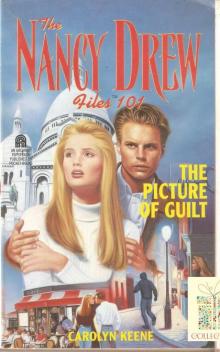 The Picture of Guilt
The Picture of Guilt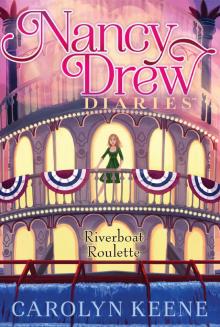 Riverboat Roulette
Riverboat Roulette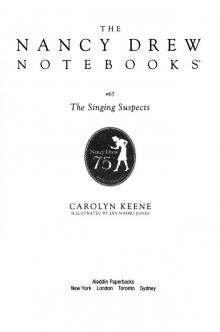 The Singing Suspects
The Singing Suspects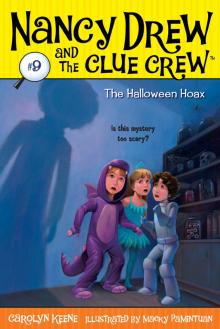 The Halloween Hoax
The Halloween Hoax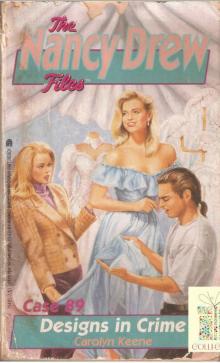 089 Designs in Crime
089 Designs in Crime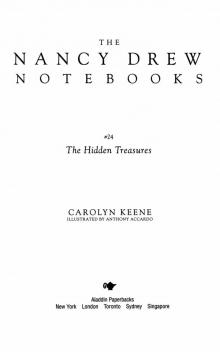 The Hidden Treasures
The Hidden Treasures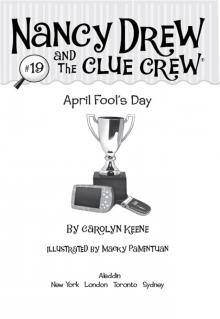 April Fool's Day
April Fool's Day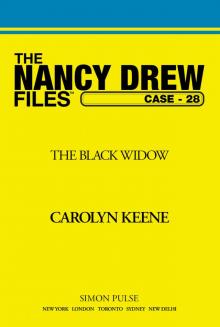 The Black Widow
The Black Widow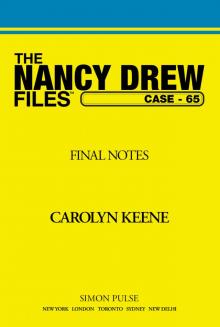 Final Notes
Final Notes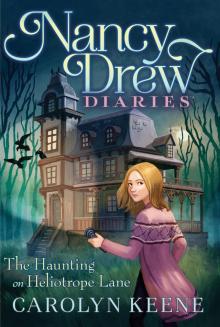 The Haunting on Heliotrope Lane
The Haunting on Heliotrope Lane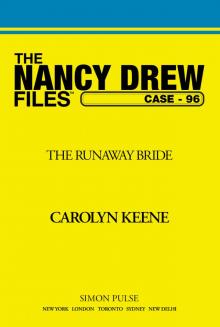 The Runaway Bride
The Runaway Bride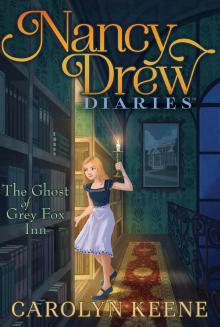 The Ghost of Grey Fox Inn
The Ghost of Grey Fox Inn The Hidden Staircase
The Hidden Staircase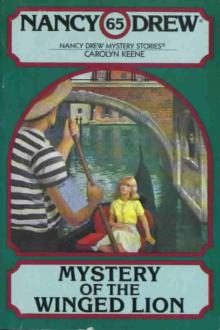 Mystery of the Winged Lion
Mystery of the Winged Lion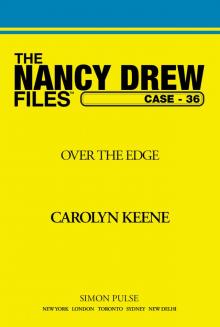 Over the Edge
Over the Edge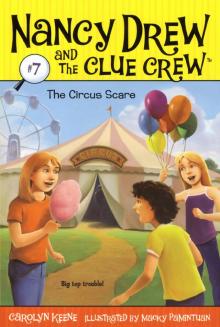 The Circus Scare
The Circus Scare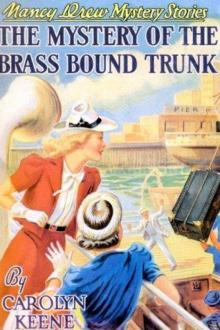 The Mystery of the Brass-Bound Trunk
The Mystery of the Brass-Bound Trunk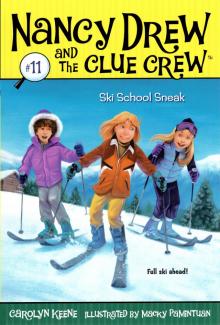 Ski School Sneak
Ski School Sneak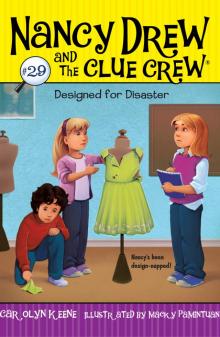 Designed for Disaster
Designed for Disaster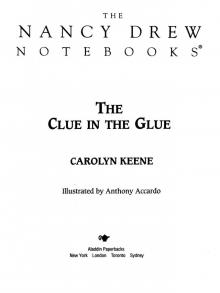 The Clue in the Glue
The Clue in the Glue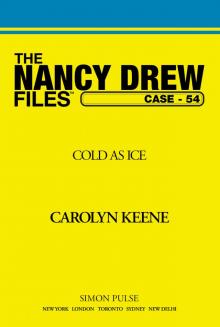 Cold as Ice
Cold as Ice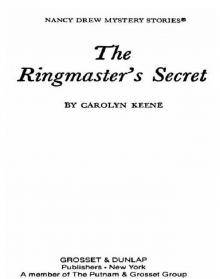 The Ringmaster's Secret
The Ringmaster's Secret 013 Wings of Fear
013 Wings of Fear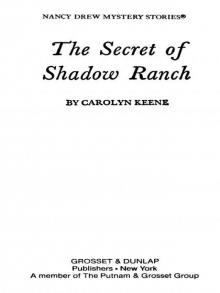 The Secret of Shadow Ranch
The Secret of Shadow Ranch Not Nice on Ice
Not Nice on Ice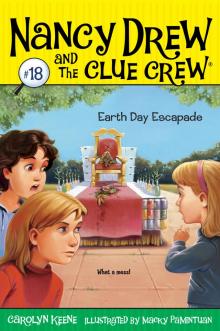 Earth Day Escapade
Earth Day Escapade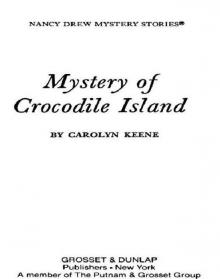 Mystery of Crocodile Island
Mystery of Crocodile Island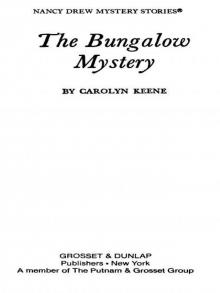 The Bungalow Mystery
The Bungalow Mystery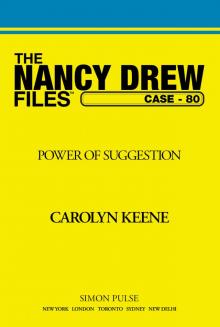 Power of Suggestion
Power of Suggestion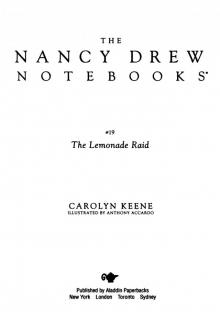 The Lemonade Raid
The Lemonade Raid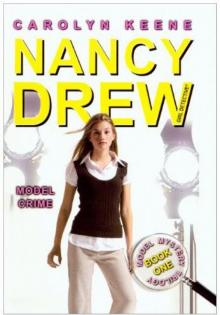 Model Crime
Model Crime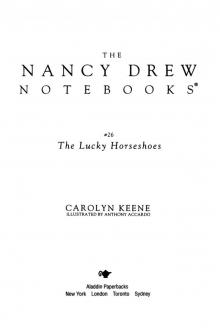 The Lucky Horseshoes
The Lucky Horseshoes The Secret of the Old Clock
The Secret of the Old Clock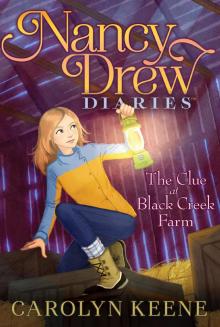 The Clue at Black Creek Farm
The Clue at Black Creek Farm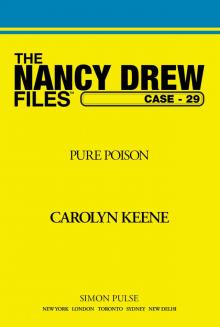 Pure Poison
Pure Poison Nobody's Business
Nobody's Business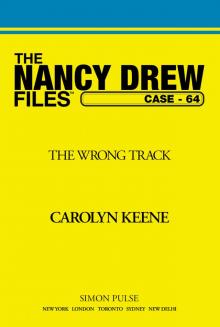 Wrong Track
Wrong Track Chick-Napped!
Chick-Napped!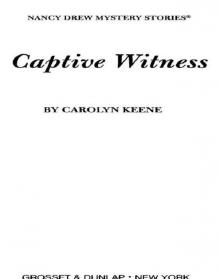 Captive Witness
Captive Witness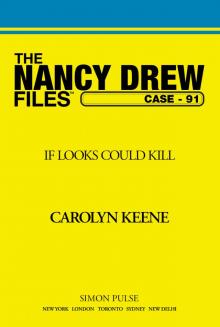 If Looks Could Kill
If Looks Could Kill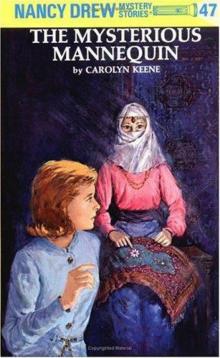 The Mysterious Mannequin
The Mysterious Mannequin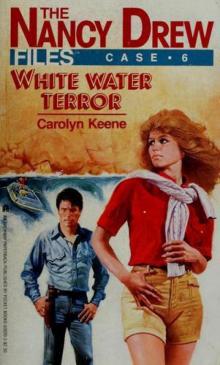 White Water Terror
White Water Terror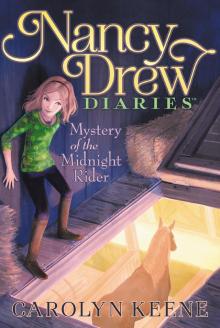 Mystery of the Midnight Rider
Mystery of the Midnight Rider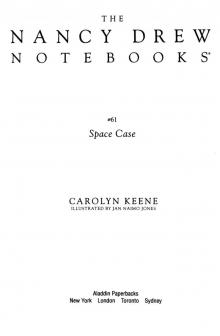 Space Case
Space Case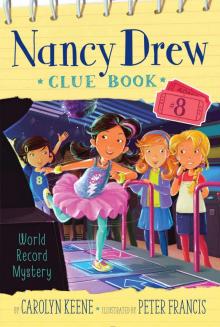 World Record Mystery
World Record Mystery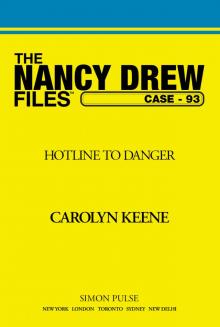 Hotline to Danger
Hotline to Danger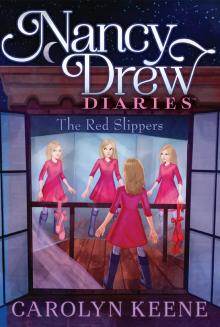 The Red Slippers
The Red Slippers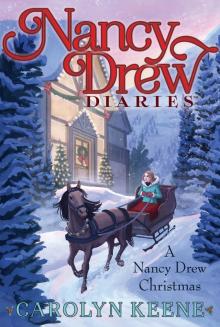 A Crime for Christmas
A Crime for Christmas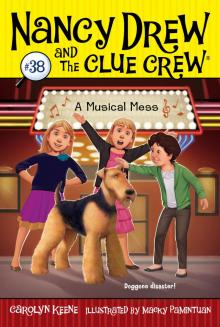 A Musical Mess
A Musical Mess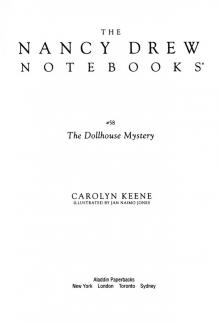 The Dollhouse Mystery
The Dollhouse Mystery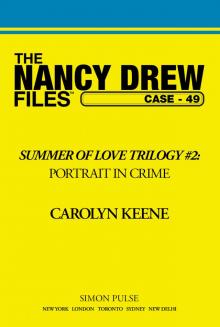 Portrait in Crime
Portrait in Crime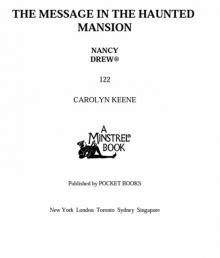 The Message in the Haunted Mansion
The Message in the Haunted Mansion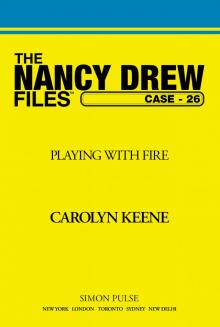 Playing With Fire
Playing With Fire Mystery of the Tolling Bell
Mystery of the Tolling Bell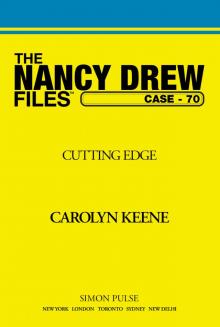 Cutting Edge
Cutting Edge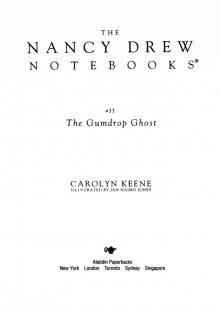 The Gumdrop Ghost
The Gumdrop Ghost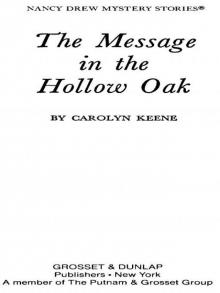 The Message in the Hollow Oak
The Message in the Hollow Oak Trial by Fire
Trial by Fire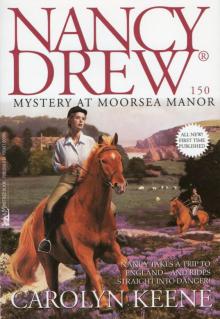 Mystery at Moorsea Manor
Mystery at Moorsea Manor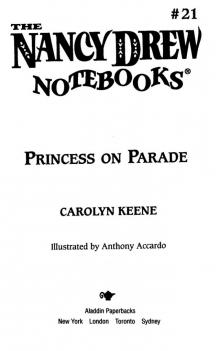 Princess on Parade
Princess on Parade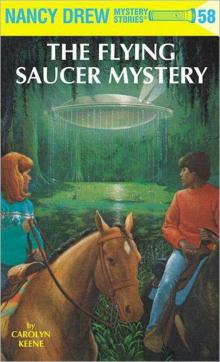 The Flying Saucer Mystery
The Flying Saucer Mystery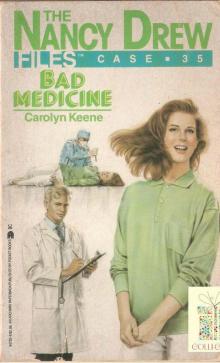 035 Bad Medicine
035 Bad Medicine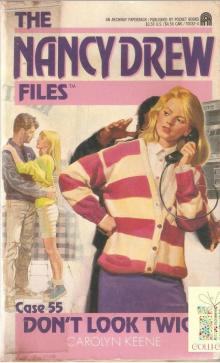 055 Don't Look Twice
055 Don't Look Twice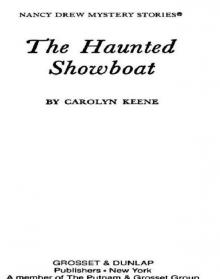 The Haunted Showboat
The Haunted Showboat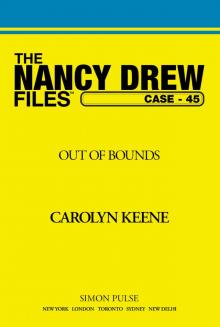 Out of Bounds
Out of Bounds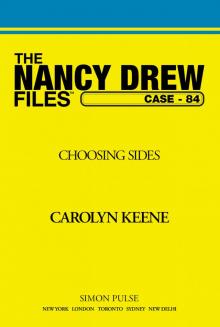 Choosing Sides
Choosing Sides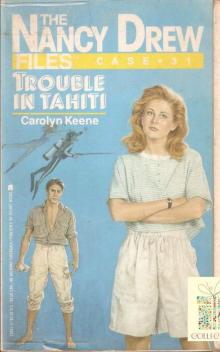 031 Trouble in Tahiti
031 Trouble in Tahiti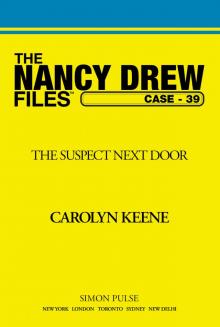 The Suspect Next Door
The Suspect Next Door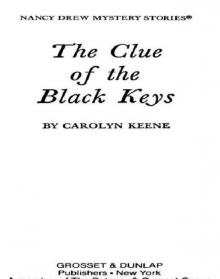 The Clue of the Black Keys
The Clue of the Black Keys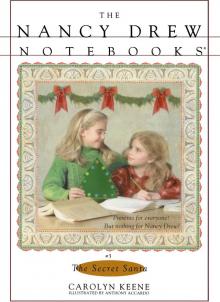 The Secret Santa
The Secret Santa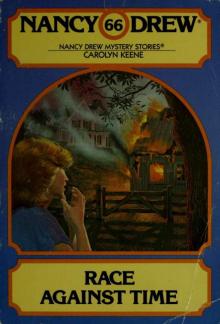 Race Against Time
Race Against Time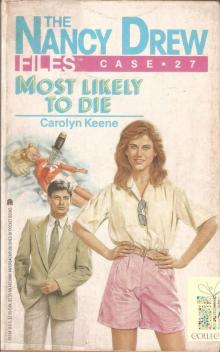 027 Most Likely to Die
027 Most Likely to Die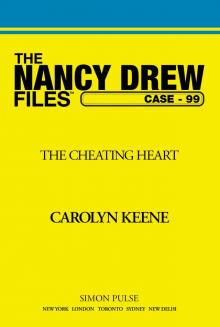 The Cheating Heart
The Cheating Heart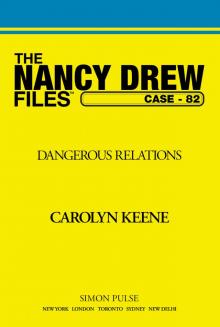 Dangerous Relations
Dangerous Relations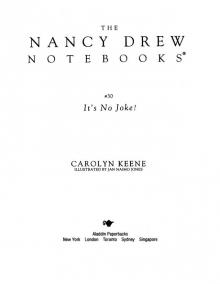 It's No Joke!
It's No Joke!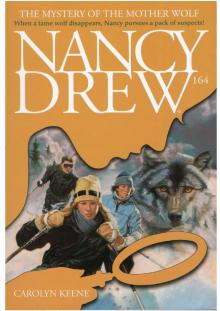 The Mystery of the Mother Wolf
The Mystery of the Mother Wolf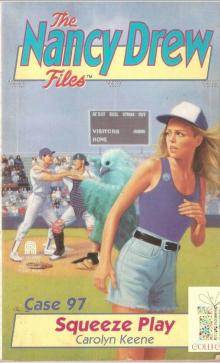 097 Squeeze Play
097 Squeeze Play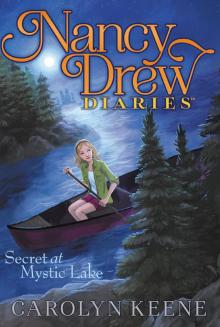 Secret at Mystic Lake
Secret at Mystic Lake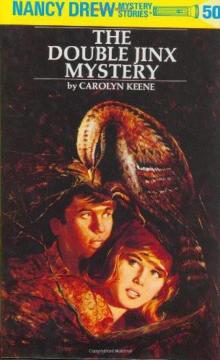 The Double Jinx Mystery
The Double Jinx Mystery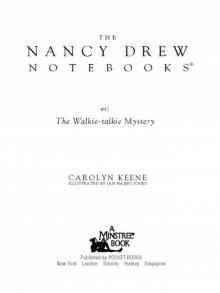 The Walkie Talkie Mystery
The Walkie Talkie Mystery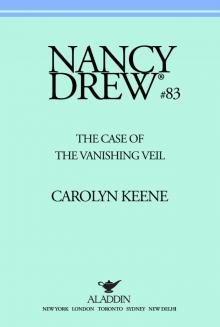 The Case of the Vanishing Veil
The Case of the Vanishing Veil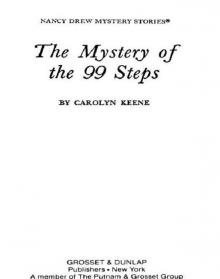 The Mystery of the 99 Steps
The Mystery of the 99 Steps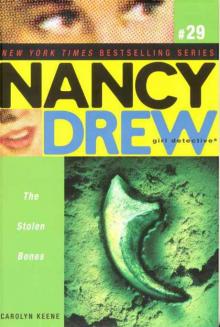 The Stolen Bones
The Stolen Bones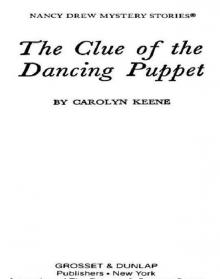 The Clue of the Dancing Puppet
The Clue of the Dancing Puppet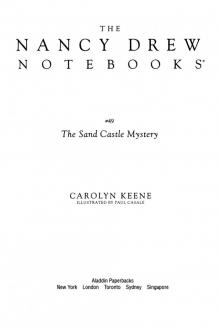 The Sand Castle Mystery
The Sand Castle Mystery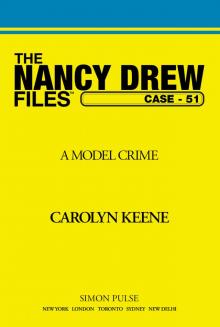 A Model Crime
A Model Crime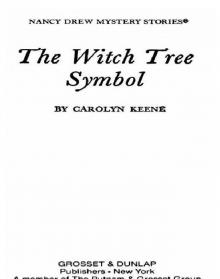 The Witch Tree Symbol
The Witch Tree Symbol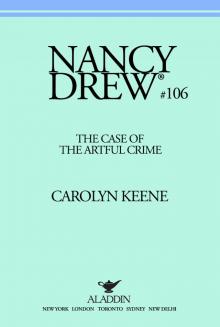 The Case of the Artful Crime
The Case of the Artful Crime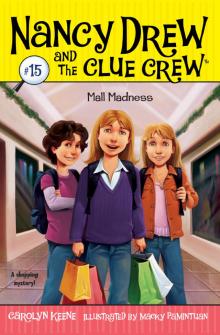 Mall Madness
Mall Madness Swiss Secrets
Swiss Secrets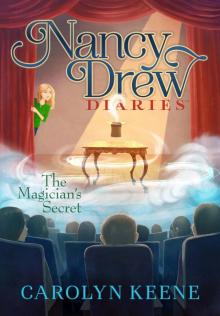 The Magician's Secret
The Magician's Secret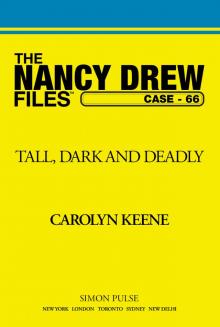 Tall, Dark and Deadly
Tall, Dark and Deadly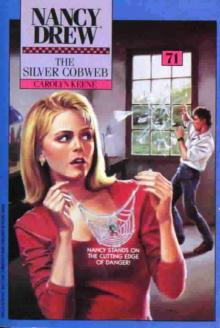 The Silver Cobweb
The Silver Cobweb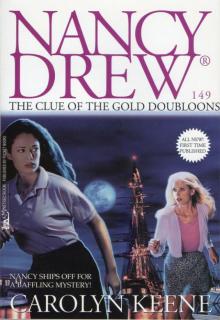 The Clue of the Gold Doubloons
The Clue of the Gold Doubloons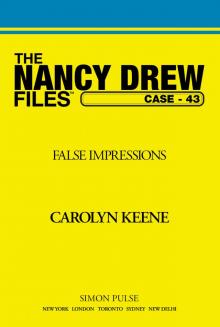 False Impressions
False Impressions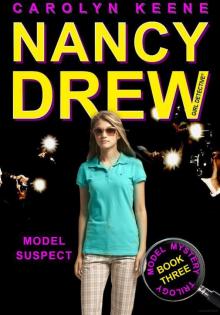 Model Suspect
Model Suspect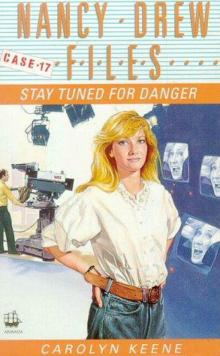 Stay Tuned for Danger
Stay Tuned for Danger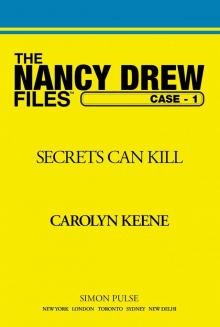 Secrets Can Kill
Secrets Can Kill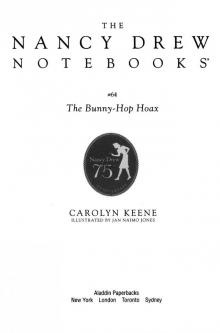 The Bunny-Hop Hoax
The Bunny-Hop Hoax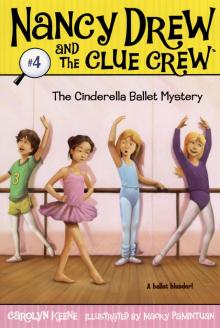 The Cinderella Ballet Mystery
The Cinderella Ballet Mystery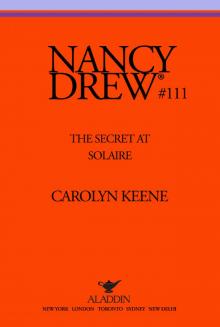 The Secret at Solaire
The Secret at Solaire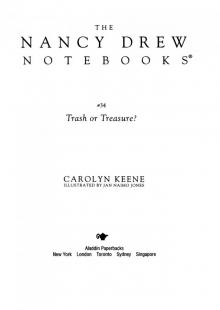 Trash or Treasure?
Trash or Treasure? The Missing Horse Mystery
The Missing Horse Mystery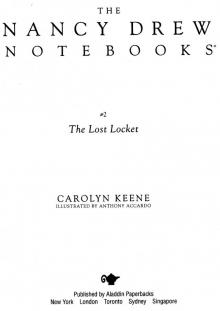 The Lost Locket
The Lost Locket The Secret of the Wooden Lady
The Secret of the Wooden Lady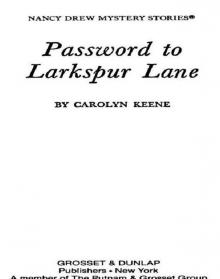 Password to Larkspur Lane
Password to Larkspur Lane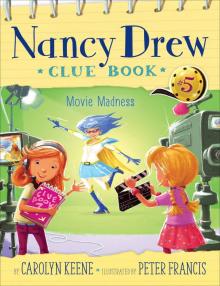 Movie Madness
Movie Madness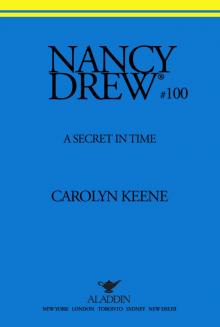 A Secret in Time
A Secret in Time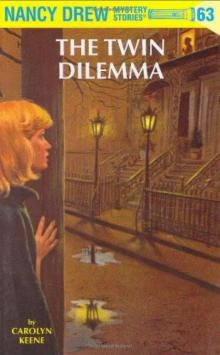 The Twin Dilemma
The Twin Dilemma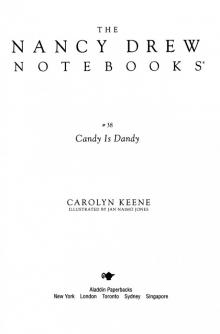 Candy Is Dandy
Candy Is Dandy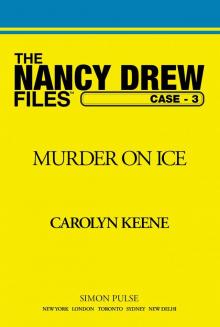 Murder on Ice
Murder on Ice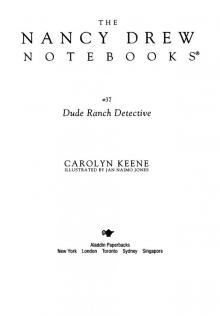 Dude Ranch Detective
Dude Ranch Detective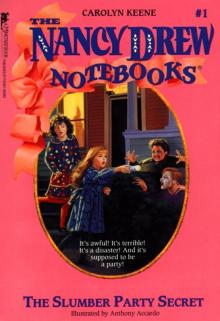 The Slumber Party Secret
The Slumber Party Secret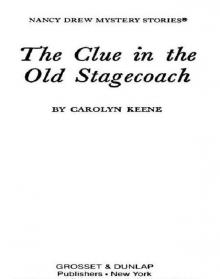 The Clue in the Old Stagecoach
The Clue in the Old Stagecoach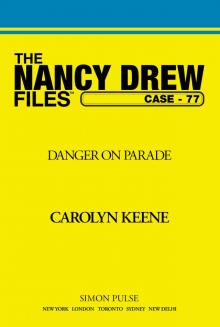 Danger on Parade
Danger on Parade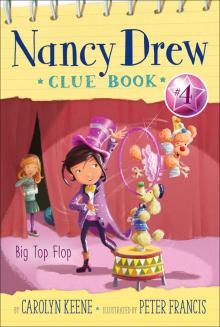 Big Top Flop
Big Top Flop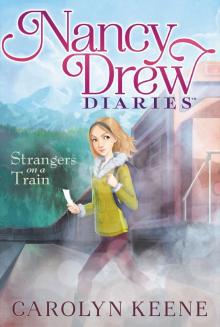 Strangers on a Train
Strangers on a Train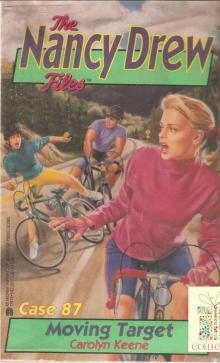 087 Moving Target
087 Moving Target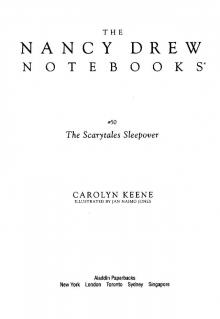 The Scarytales Sleepover
The Scarytales Sleepover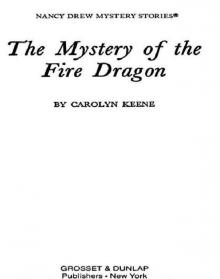 The Mystery of the Fire Dragon
The Mystery of the Fire Dragon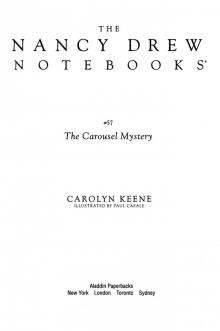 The Carousel Mystery
The Carousel Mystery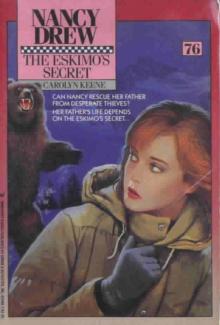 The Eskimo's Secret
The Eskimo's Secret Thrill on the Hill
Thrill on the Hill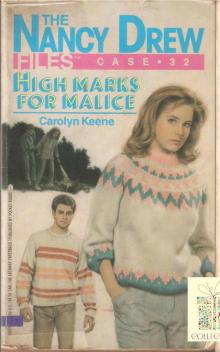 032 High Marks for Malice
032 High Marks for Malice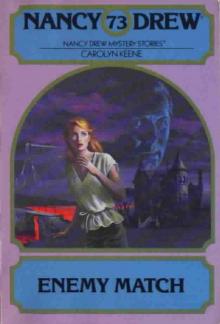 Enemy Match
Enemy Match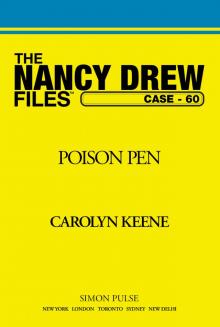 Poison Pen
Poison Pen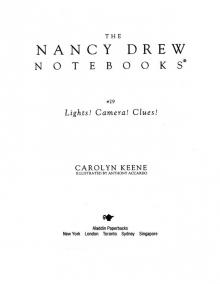 Lights, Camera . . . Cats!
Lights, Camera . . . Cats!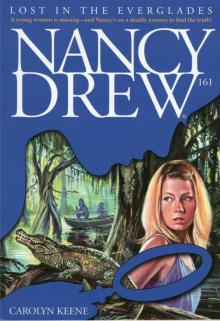 Lost in the Everglades
Lost in the Everglades Strike-Out Scare
Strike-Out Scare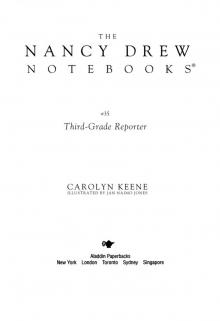 Third-Grade Reporter
Third-Grade Reporter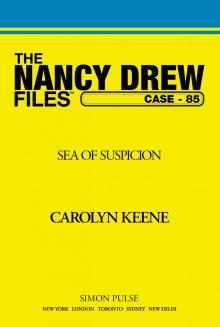 Sea of Suspicion
Sea of Suspicion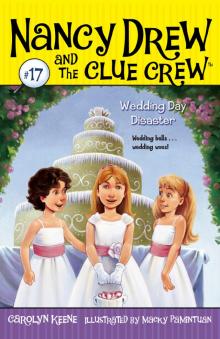 Wedding Day Disaster
Wedding Day Disaster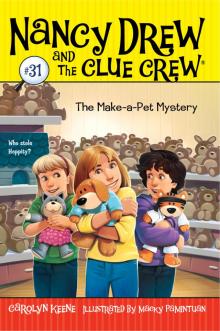 The Make-A-Pet Mystery
The Make-A-Pet Mystery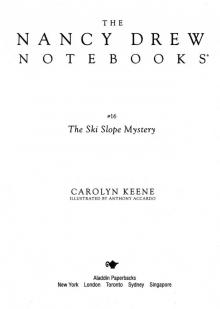 The Ski Slope Mystery
The Ski Slope Mystery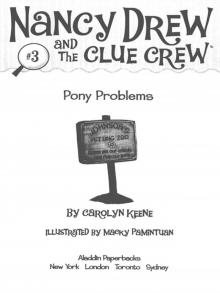 Pony Problems
Pony Problems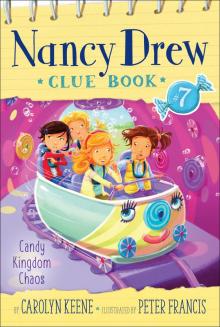 Candy Kingdom Chaos
Candy Kingdom Chaos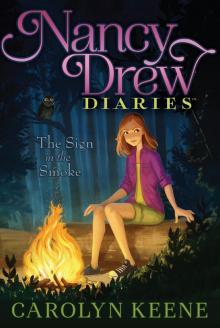 The Sign in the Smoke
The Sign in the Smoke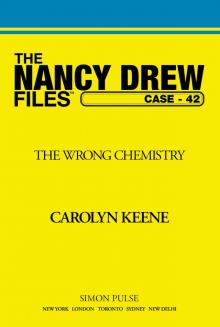 The Wrong Chemistry
The Wrong Chemistry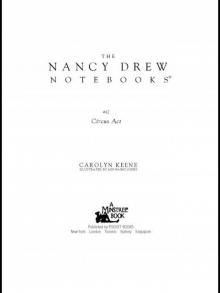 Circus Act
Circus Act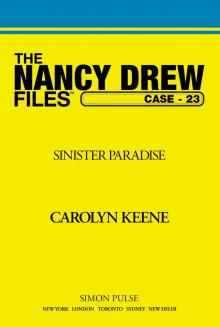 Sinister Paradise
Sinister Paradise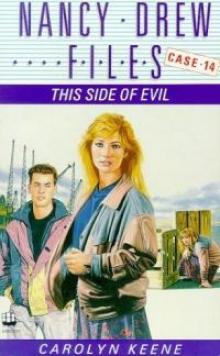 This Side of Evil
This Side of Evil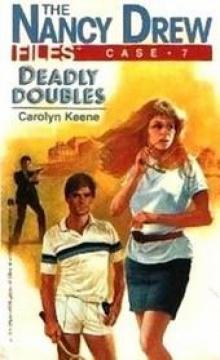 Deadly Doubles
Deadly Doubles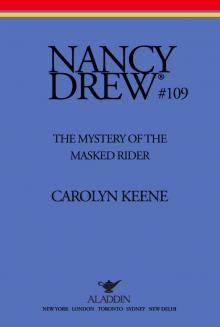 The Mystery of the Masked Rider
The Mystery of the Masked Rider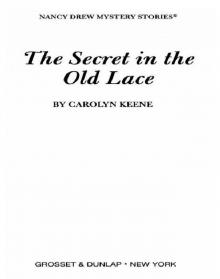 The Secret in the Old Lace
The Secret in the Old Lace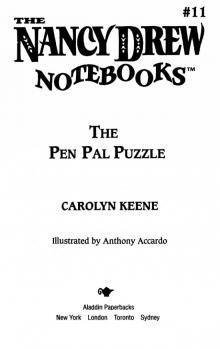 The Pen Pal Puzzle
The Pen Pal Puzzle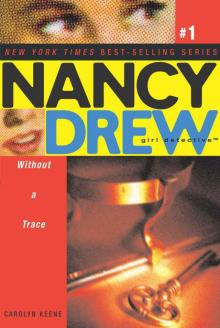 Without a Trace
Without a Trace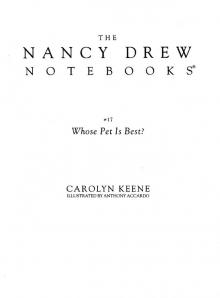 Whose Pet Is Best?
Whose Pet Is Best? Dance Till You Die
Dance Till You Die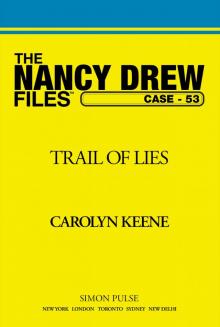 Trail of Lies
Trail of Lies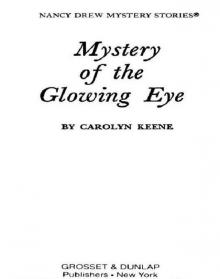 Mystery of the Glowing Eye
Mystery of the Glowing Eye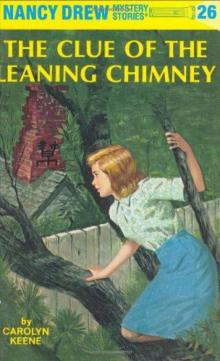 The Clue of the Leaning Chimney
The Clue of the Leaning Chimney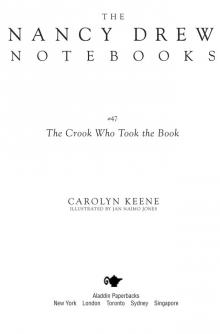 The Crook Who Took the Book
The Crook Who Took the Book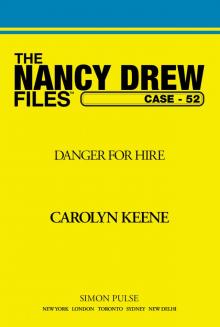 Danger for Hire
Danger for Hire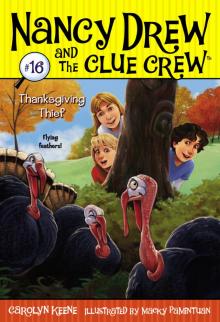 Thanksgiving Thief
Thanksgiving Thief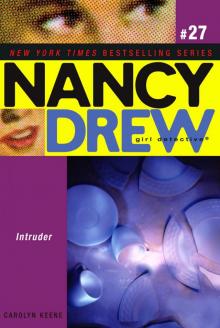 Intruder!
Intruder!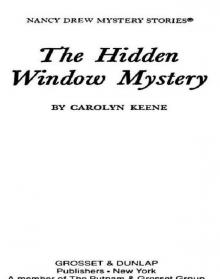 The Hidden Window Mystery
The Hidden Window Mystery Win, Place or Die
Win, Place or Die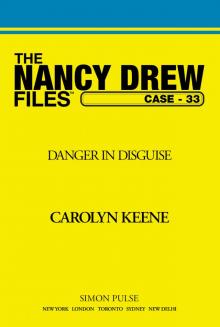 Danger in Disguise
Danger in Disguise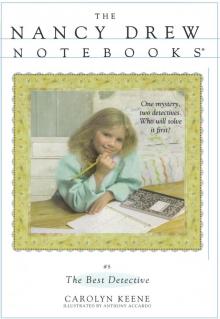 The Best Detective
The Best Detective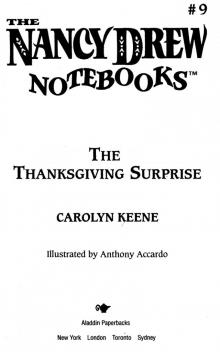 The Thanksgiving Surprise
The Thanksgiving Surprise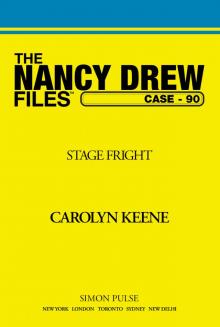 Stage Fright
Stage Fright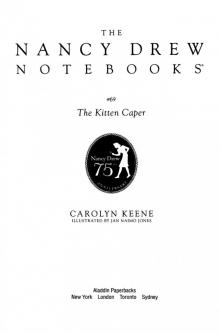 The Kitten Caper
The Kitten Caper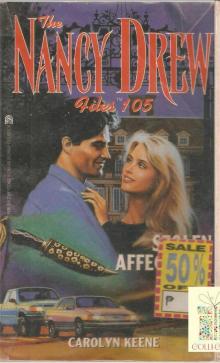 Stolen Affections
Stolen Affections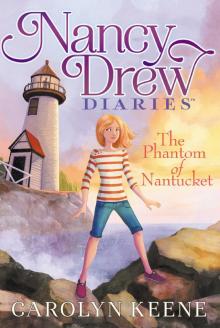 The Phantom of Nantucket
The Phantom of Nantucket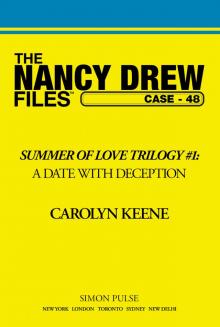 Date With Deception
Date With Deception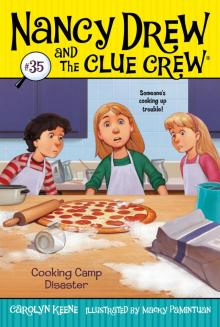 Cooking Camp Disaster
Cooking Camp Disaster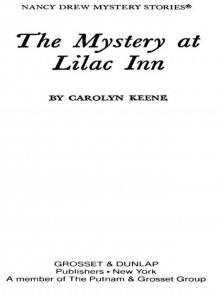 The Mystery at Lilac Inn
The Mystery at Lilac Inn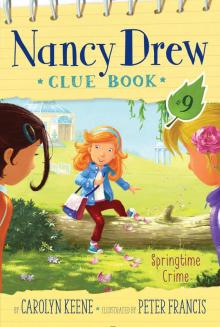 Springtime Crime
Springtime Crime Action!
Action!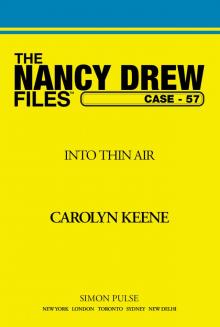 Into Thin Air
Into Thin Air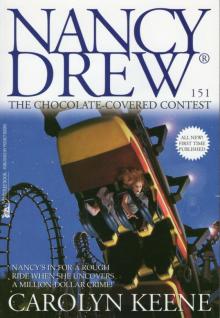 The Chocolate-Covered Contest
The Chocolate-Covered Contest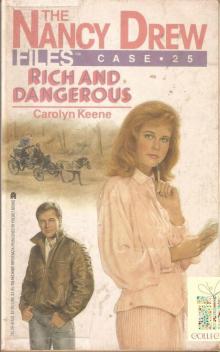 025 Rich and Dangerous
025 Rich and Dangerous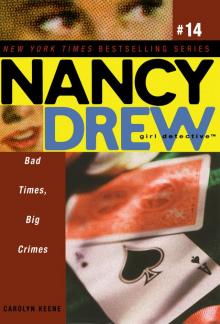 Bad Times, Big Crimes
Bad Times, Big Crimes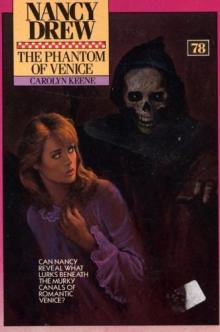 078 The Phantom Of Venice
078 The Phantom Of Venice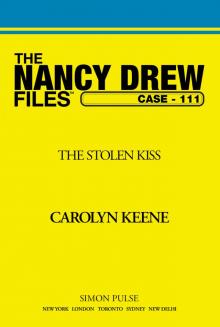 The Stolen Kiss
The Stolen Kiss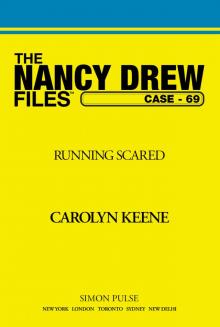 Running Scared
Running Scared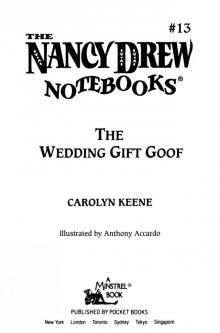 The Wedding Gift Goof
The Wedding Gift Goof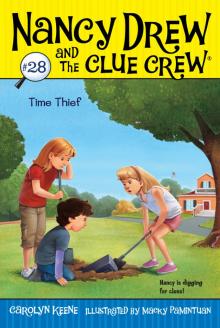 Time Thief
Time Thief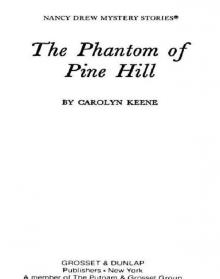 The Phantom of Pine Hill
The Phantom of Pine Hill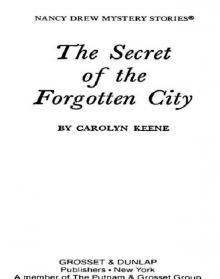 The Secret of the Forgotten City
The Secret of the Forgotten City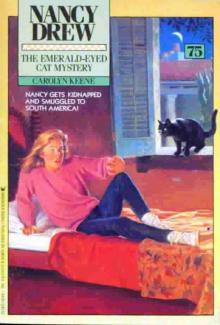 The Emerald-Eyed Cat Mystery
The Emerald-Eyed Cat Mystery 004 Smile and Say Murder
004 Smile and Say Murder Curse of the Arctic Star
Curse of the Arctic Star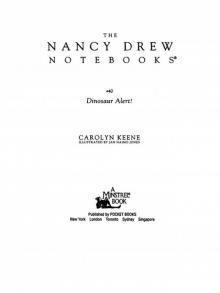 Dinosaur Alert!
Dinosaur Alert!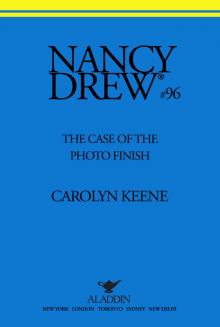 The Case of the Photo Finish
The Case of the Photo Finish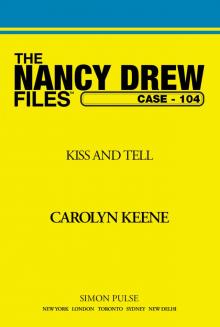 Kiss and Tell
Kiss and Tell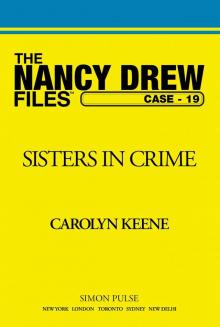 Sisters in Crime
Sisters in Crime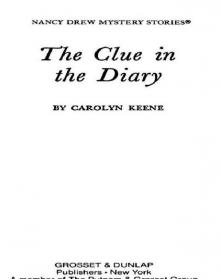 The Clue in the Diary
The Clue in the Diary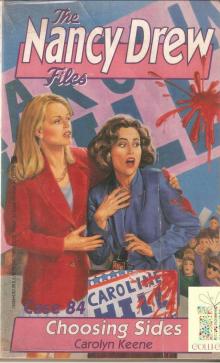 084 Choosing Sides
084 Choosing Sides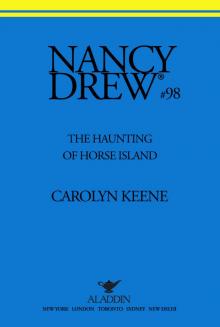 Haunting of Horse Island
Haunting of Horse Island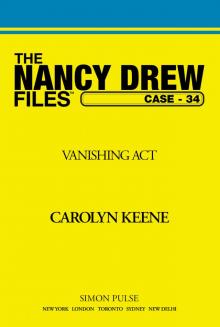 Vanishing Act
Vanishing Act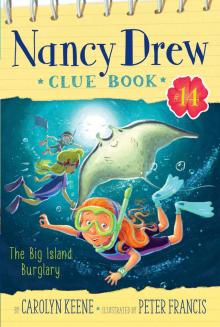 The Big Island Burglary
The Big Island Burglary Danger at the Iron Dragon
Danger at the Iron Dragon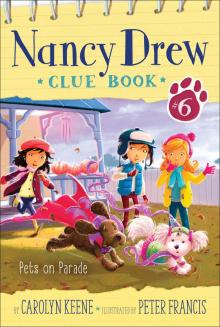 Pets on Parade
Pets on Parade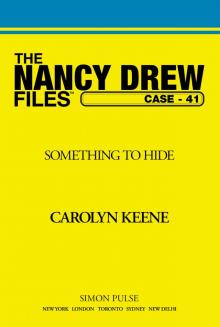 Something to Hide
Something to Hide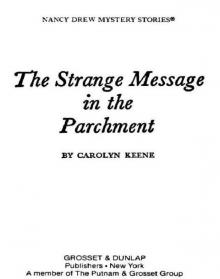 The Strange Message in the Parchment
The Strange Message in the Parchment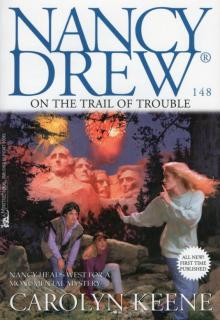 On the Trail of Trouble
On the Trail of Trouble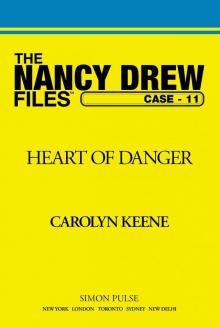 Heart of Danger
Heart of Danger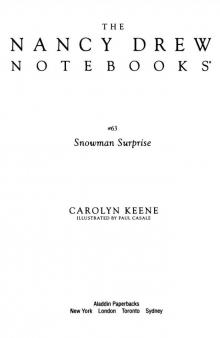 The Snowman Surprise
The Snowman Surprise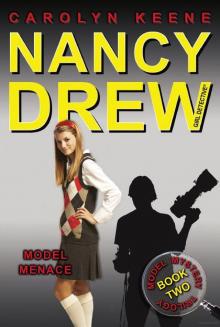 Model Menace
Model Menace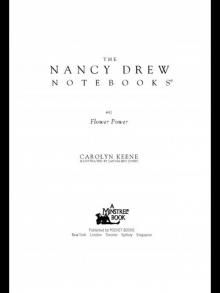 Flower Power
Flower Power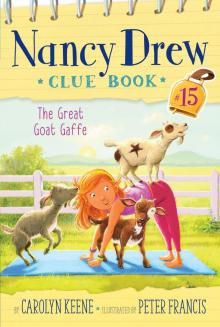 The Great Goat Gaffe
The Great Goat Gaffe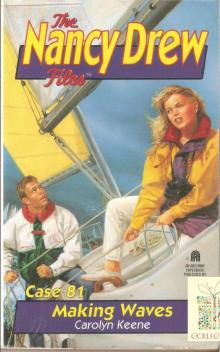 081 Making Waves
081 Making Waves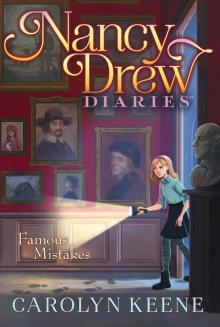 Famous Mistakes
Famous Mistakes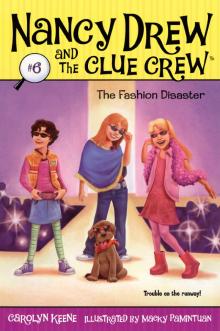 The Fashion Disaster
The Fashion Disaster The Clue in the Jewel Box
The Clue in the Jewel Box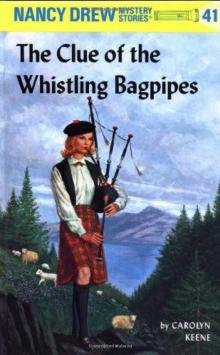 The Clue of the Whistling Bagpipes
The Clue of the Whistling Bagpipes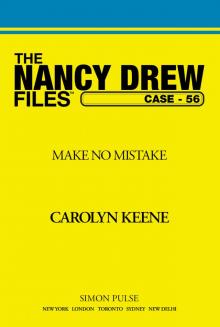 Make No Mistake
Make No Mistake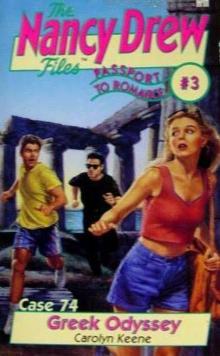 Greek Odyssey
Greek Odyssey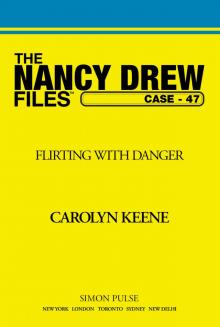 Flirting With Danger
Flirting With Danger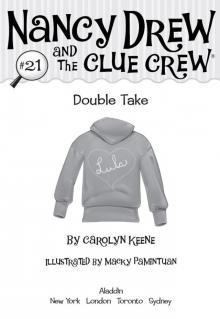 Double Take
Double Take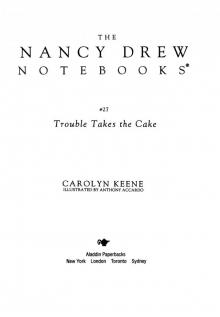 Trouble Takes the Cake
Trouble Takes the Cake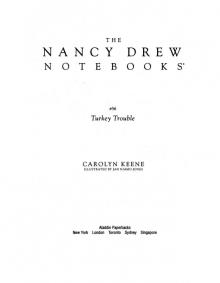 Turkey Trouble
Turkey Trouble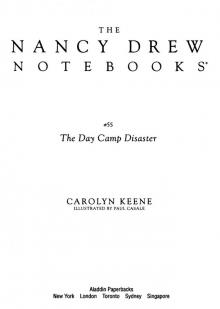 The Day Camp Disaster
The Day Camp Disaster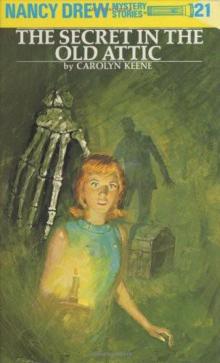 The Secret in the Old Attic
The Secret in the Old Attic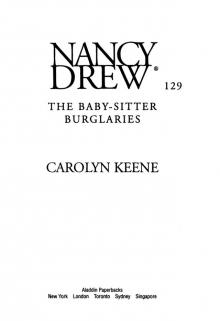 The Baby-Sitter Burglaries
The Baby-Sitter Burglaries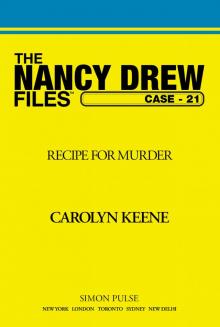 Recipe for Murder
Recipe for Murder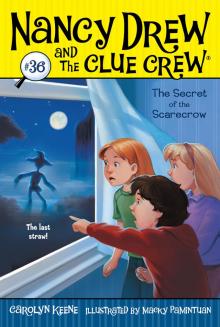 The Secret of the Scarecrow
The Secret of the Scarecrow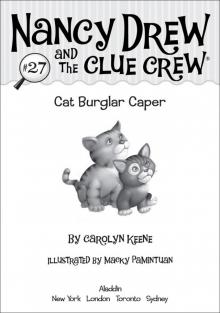 Cat Burglar Caper
Cat Burglar Caper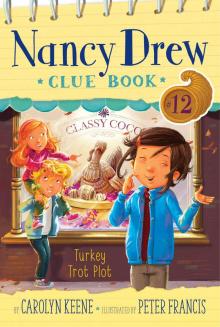 Turkey Trot Plot
Turkey Trot Plot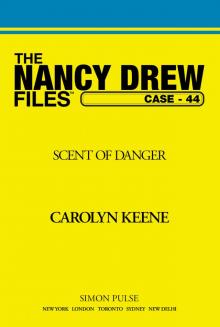 Scent of Danger
Scent of Danger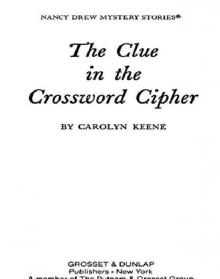 The Clue in the Crossword Cipher
The Clue in the Crossword Cipher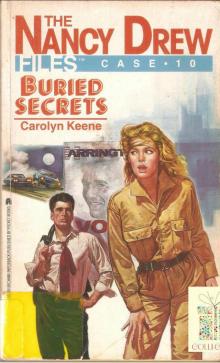 010 Buried Secrets
010 Buried Secrets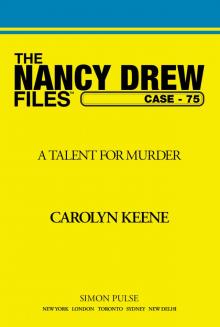 A Talent for Murder
A Talent for Murder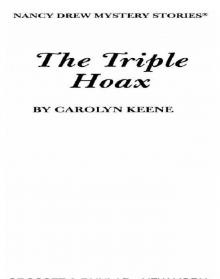 The Triple Hoax
The Triple Hoax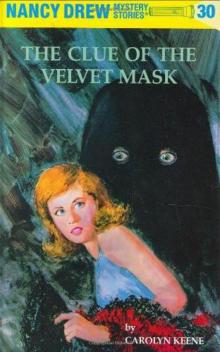 The Clue of the Velvet Mask
The Clue of the Velvet Mask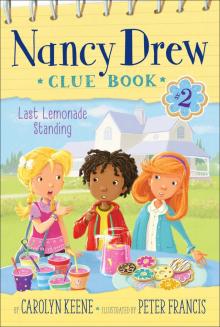 Last Lemonade Standing
Last Lemonade Standing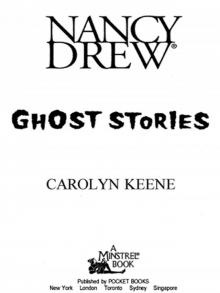 The Ghost of Blackwood Hall
The Ghost of Blackwood Hall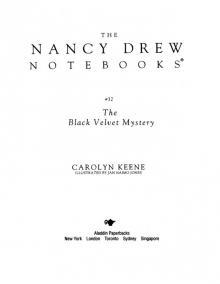 The Black Velvet Mystery
The Black Velvet Mystery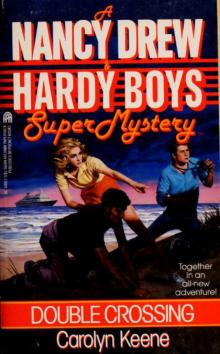 Double Crossing
Double Crossing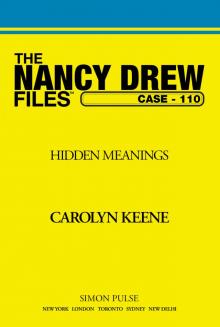 Hidden Meanings
Hidden Meanings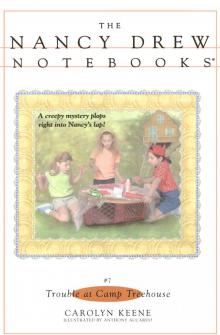 Trouble at Camp Treehouse
Trouble at Camp Treehouse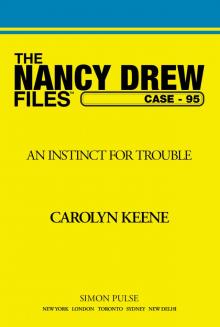 An Instinct for Trouble
An Instinct for Trouble 037 Last Dance
037 Last Dance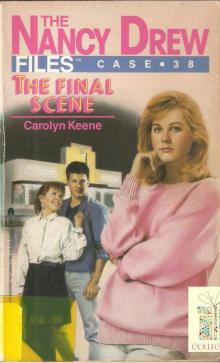 038 The Final Scene
038 The Final Scene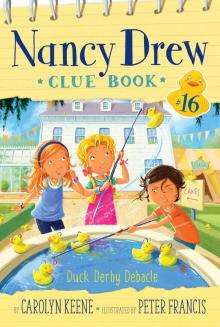 Duck Derby Debacle
Duck Derby Debacle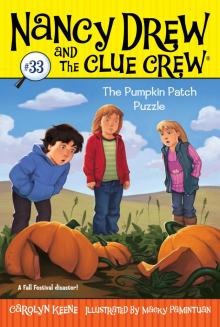 The Pumpkin Patch Puzzle
The Pumpkin Patch Puzzle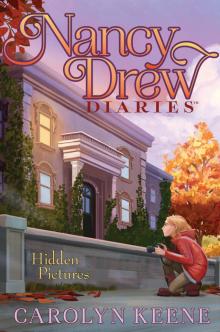 Hidden Pictures
Hidden Pictures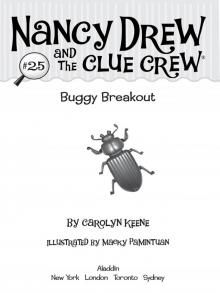 Buggy Breakout
Buggy Breakout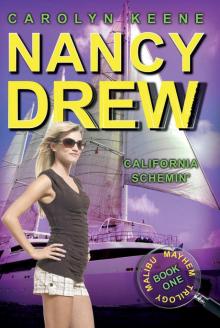 California Schemin'
California Schemin'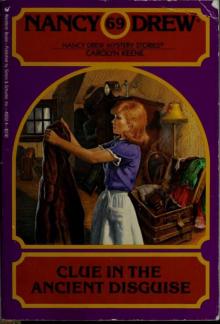 Clue in the Ancient Disguise
Clue in the Ancient Disguise Case of the Sneaky Snowman
Case of the Sneaky Snowman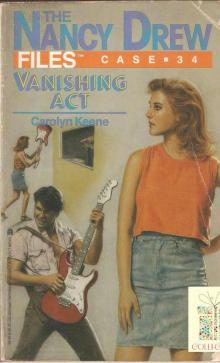 034 Vanishing Act
034 Vanishing Act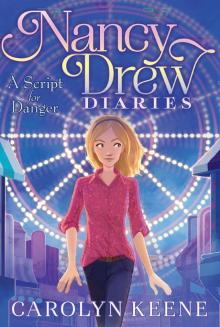 A Script for Danger
A Script for Danger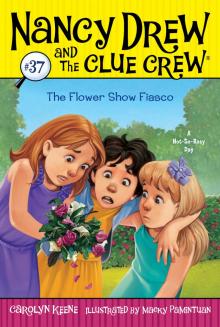 The Flower Show Fiasco
The Flower Show Fiasco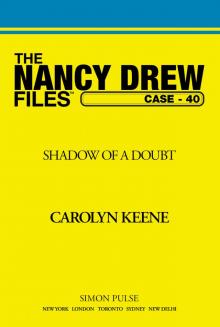 Shadow of a Doubt
Shadow of a Doubt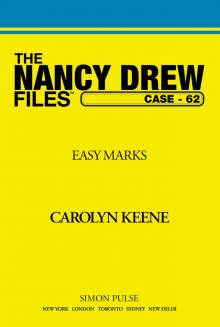 Easy Marks
Easy Marks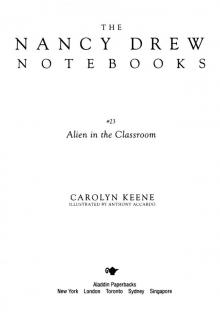 Alien in the Classroom
Alien in the Classroom Ghost Stories, #2 (Nancy Drew)
Ghost Stories, #2 (Nancy Drew)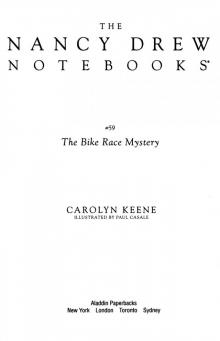 The Bike Race Mystery
The Bike Race Mystery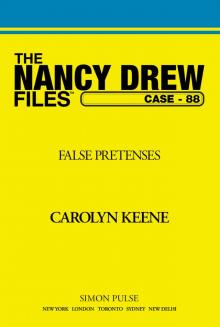 False Pretenses
False Pretenses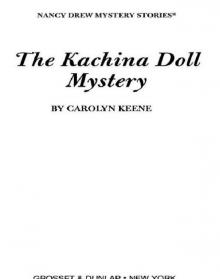 The Kachina Doll Mystery
The Kachina Doll Mystery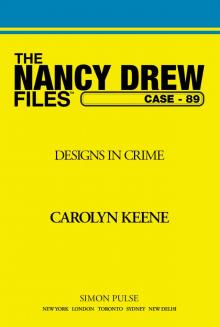 Designs in Crime
Designs in Crime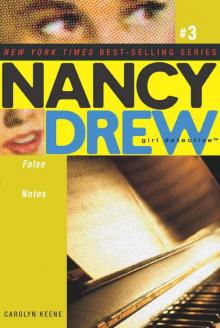 False Notes
False Notes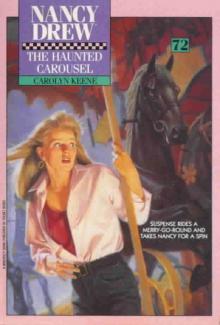 The Haunted Carousel
The Haunted Carousel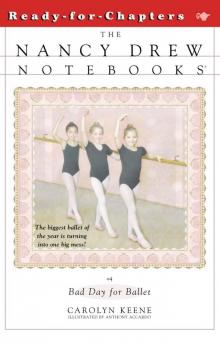 Bad Day for Ballet
Bad Day for Ballet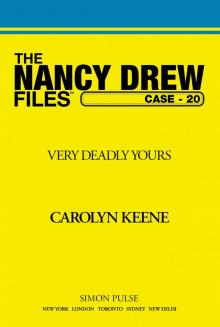 Very Deadly Yours
Very Deadly Yours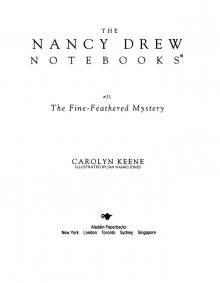 The Fine-Feathered Mystery
The Fine-Feathered Mystery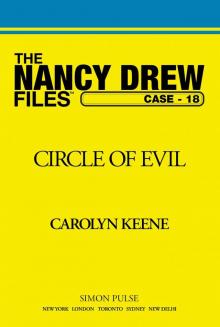 Circle of Evil
Circle of Evil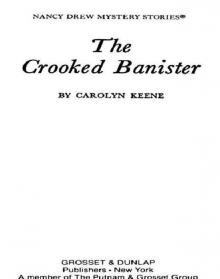 The Crooked Banister
The Crooked Banister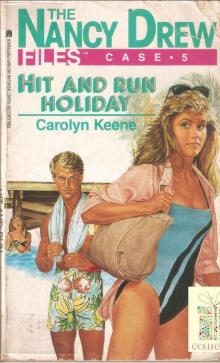 005 Hit and Run Holiday
005 Hit and Run Holiday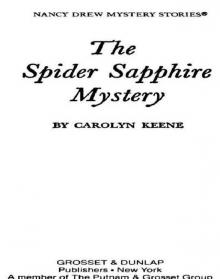 The Spider Sapphire Mystery
The Spider Sapphire Mystery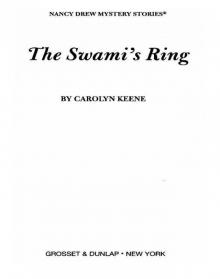 The Swami's Ring
The Swami's Ring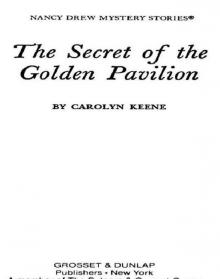 The Secret of the Golden Pavilion
The Secret of the Golden Pavilion Recipe for Trouble
Recipe for Trouble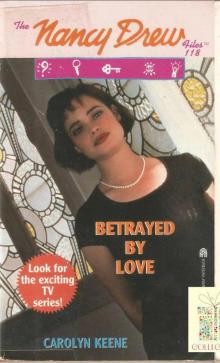 Betrayed by Love
Betrayed by Love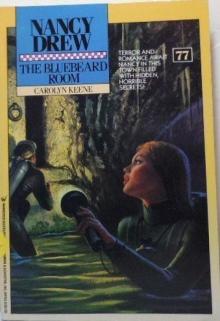 The Bluebeard Room
The Bluebeard Room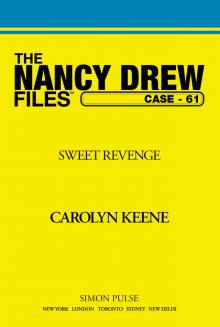 Sweet Revenge
Sweet Revenge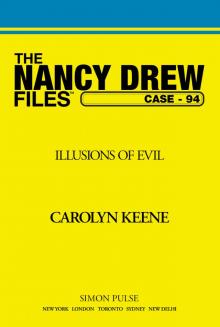 Illusions of Evil
Illusions of Evil 006 White Water Terror
006 White Water Terror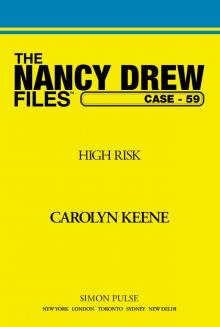 High Risk
High Risk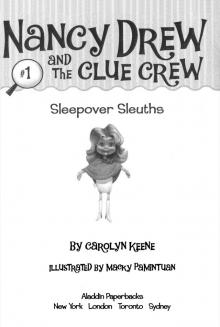 Sleepover Sleuths
Sleepover Sleuths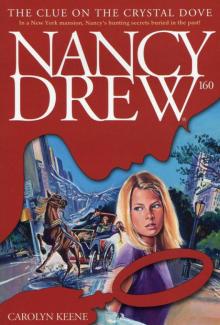 The Clue on the Crystal Dove
The Clue on the Crystal Dove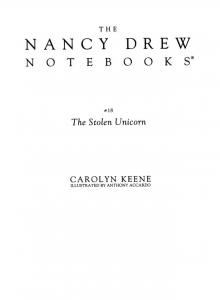 The Stolen Unicorn
The Stolen Unicorn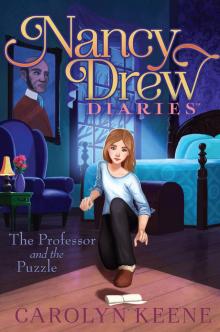 The Professor and the Puzzle
The Professor and the Puzzle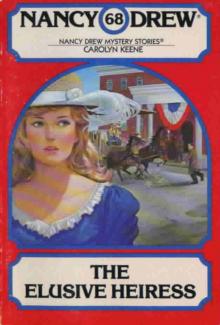 The Elusive Heiress
The Elusive Heiress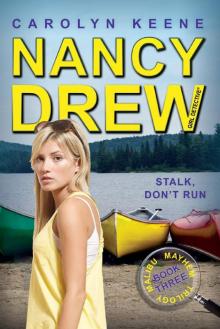 Stalk, Don't Run
Stalk, Don't Run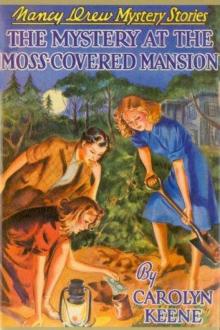 The Mystery at the Moss-Covered Mansion
The Mystery at the Moss-Covered Mansion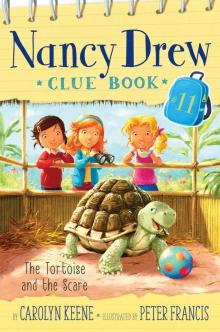 The Tortoise and the Scare
The Tortoise and the Scare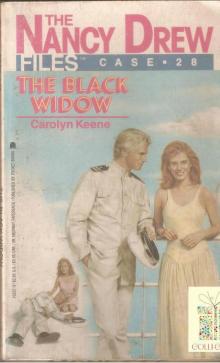 028 The Black Widow
028 The Black Widow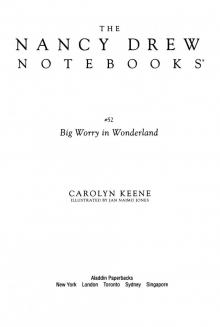 Big Worry in Wonderland
Big Worry in Wonderland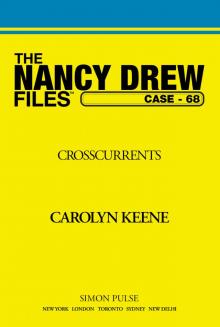 Crosscurrents
Crosscurrents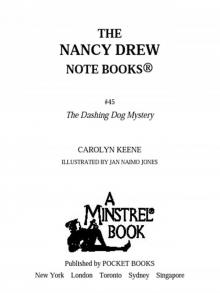 The Dashing Dog Mystery
The Dashing Dog Mystery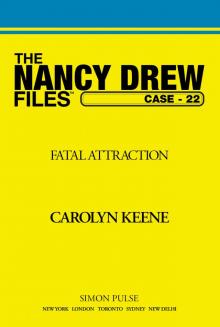 Fatal Attraction
Fatal Attraction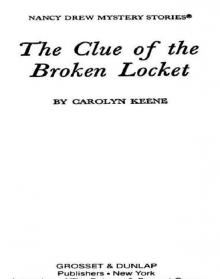 The Clue of the Broken Locket
The Clue of the Broken Locket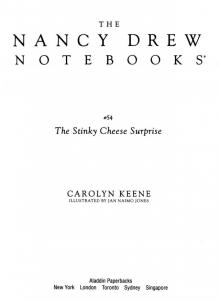 The Stinky Cheese Surprise
The Stinky Cheese Surprise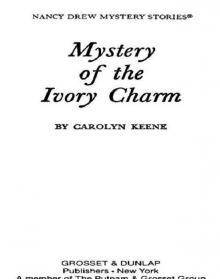 Mystery of the Ivory Charm
Mystery of the Ivory Charm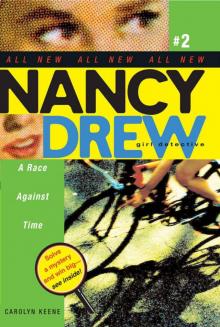 A Race Against Time
A Race Against Time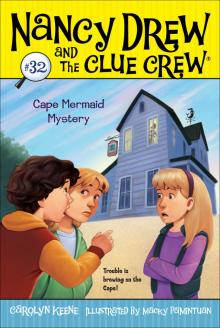 Cape Mermaid Mystery
Cape Mermaid Mystery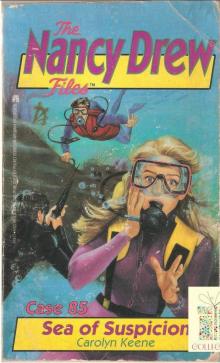 085 Sea of Suspicion
085 Sea of Suspicion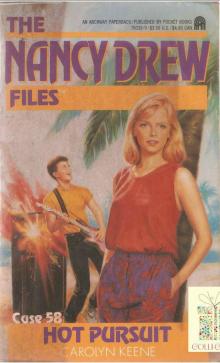 058 Hot Pursuit
058 Hot Pursuit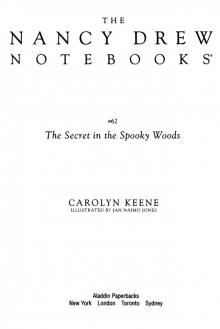 The Secret in the Spooky Woods
The Secret in the Spooky Woods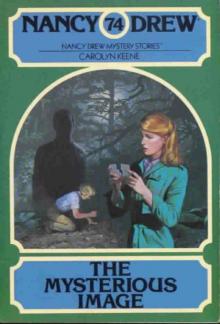 The Mysterious Image
The Mysterious Image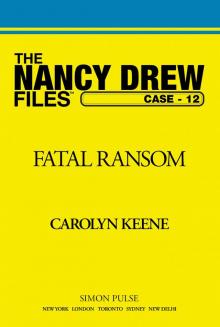 Fatal Ransom
Fatal Ransom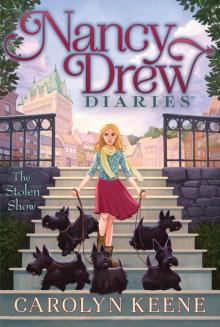 The Stolen Show
The Stolen Show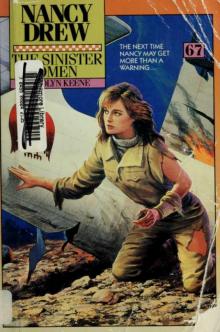 The Sinister Omen
The Sinister Omen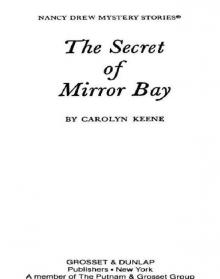 The Secret of Mirror Bay
The Secret of Mirror Bay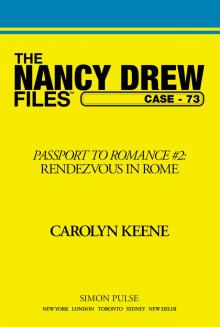 Rendezvous in Rome
Rendezvous in Rome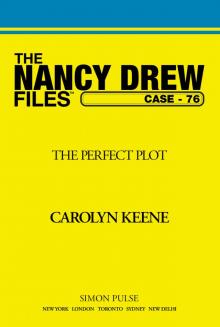 The Perfect Plot
The Perfect Plot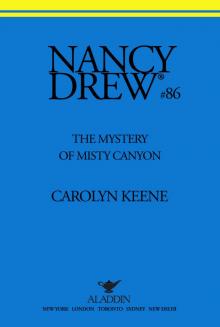 The Mystery of Misty Canyon
The Mystery of Misty Canyon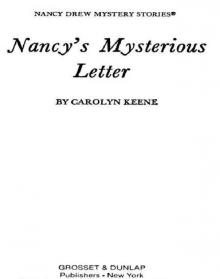 Nancy's Mysterious Letter
Nancy's Mysterious Letter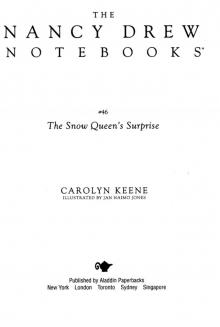 The Snow Queen's Surprise
The Snow Queen's Surprise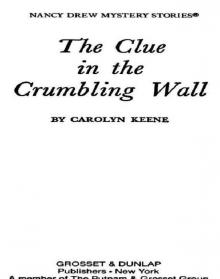 The Clue in the Crumbling Wall
The Clue in the Crumbling Wall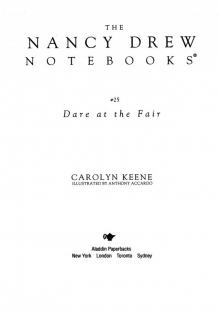 Dare at the Fair
Dare at the Fair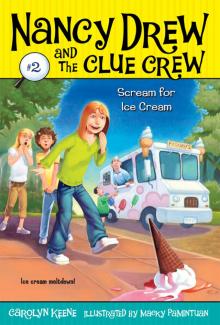 Scream for Ice Cream
Scream for Ice Cream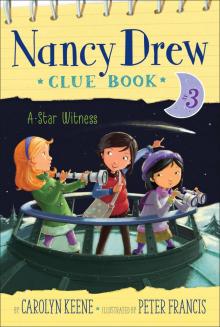 A Star Witness
A Star Witness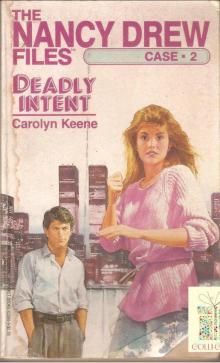 002 Deadly Intent
002 Deadly Intent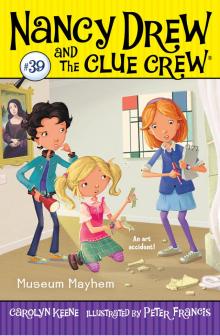 Museum Mayhem
Museum Mayhem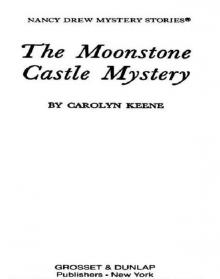 The Moonstone Castle Mystery
The Moonstone Castle Mystery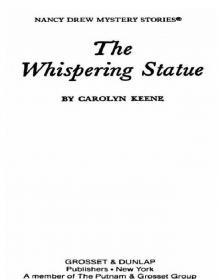 The Whispering Statue
The Whispering Statue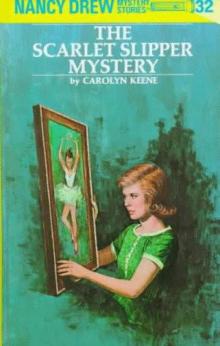 The Scarlet Slipper Mystery
The Scarlet Slipper Mystery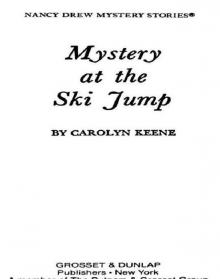 Mystery at the Ski Jump
Mystery at the Ski Jump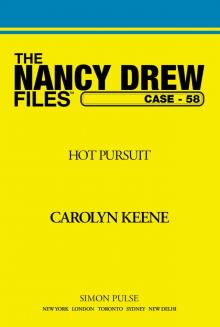 Hot Pursuit
Hot Pursuit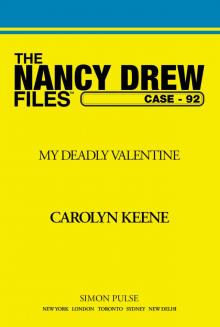 My Deadly Valentine
My Deadly Valentine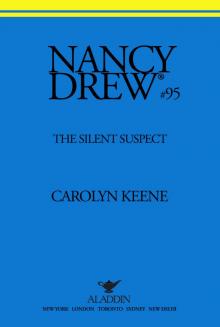 The Silent Suspect
The Silent Suspect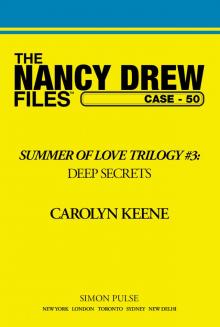 Deep Secrets
Deep Secrets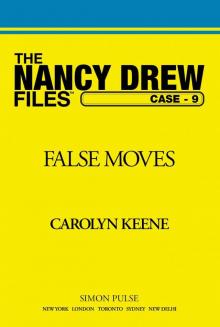 False Moves
False Moves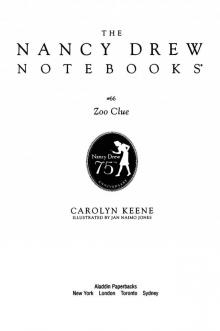 The Zoo Crew
The Zoo Crew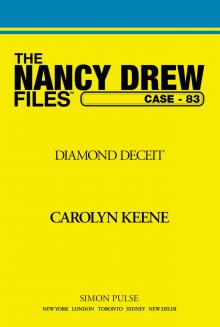 Diamond Deceit
Diamond Deceit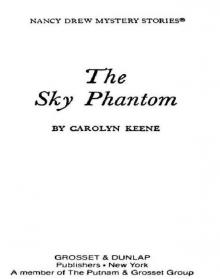 The Sky Phantom
The Sky Phantom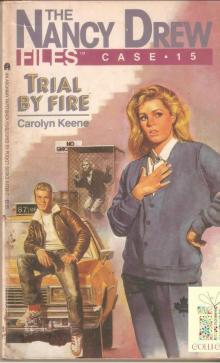 015 Trial by Fire
015 Trial by Fire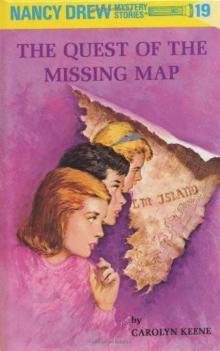 The Quest of the Missing Map
The Quest of the Missing Map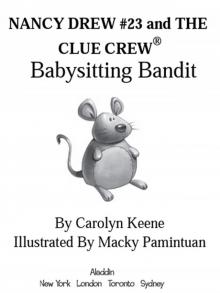 Babysitting Bandit
Babysitting Bandit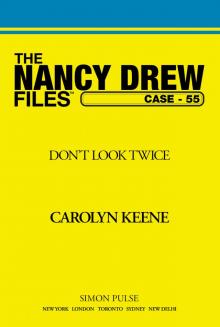 Don't Look Twice
Don't Look Twice Never Say Die
Never Say Die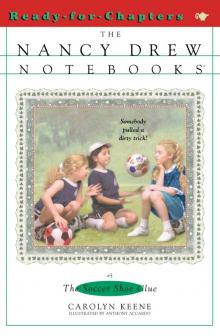 The Soccer Shoe Clue
The Soccer Shoe Clue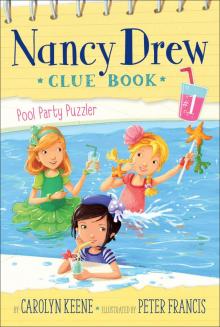 Pool Party Puzzler
Pool Party Puzzler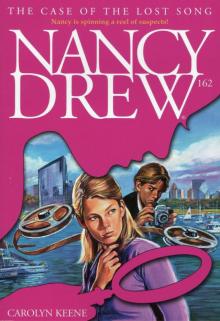 The Case of the Lost Song
The Case of the Lost Song The Apple Bandit
The Apple Bandit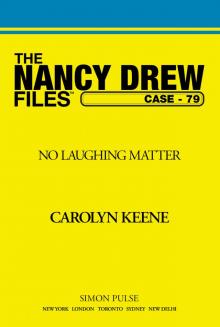 No Laughing Matter
No Laughing Matter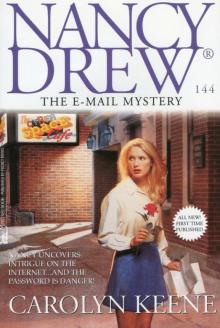 The Thirteenth Pearl
The Thirteenth Pearl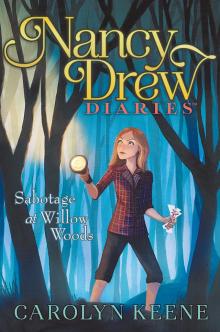 Sabotage at Willow Woods
Sabotage at Willow Woods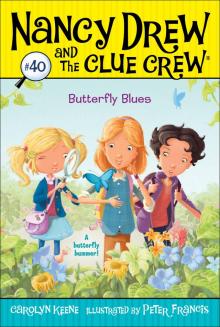 Butterfly Blues
Butterfly Blues Model Crime 1
Model Crime 1 The Nancy Drew Sleuth Book
The Nancy Drew Sleuth Book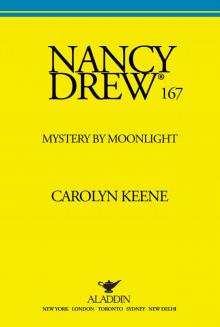 Mystery by Moonlight
Mystery by Moonlight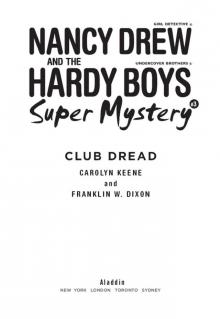 Club Dread
Club Dread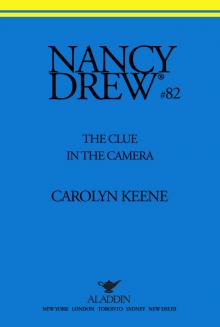 The Clue in the Camera
The Clue in the Camera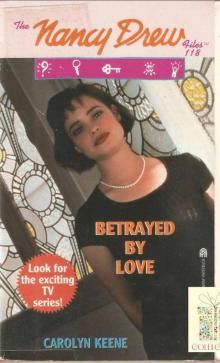 118 Betrayed By Love
118 Betrayed By Love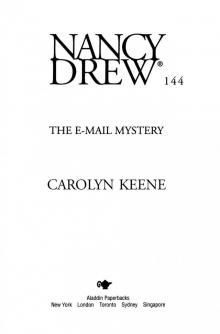 The E-Mail Mystery (Nancy Drew Book 144)
The E-Mail Mystery (Nancy Drew Book 144)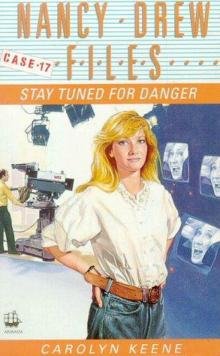 Stay Tuned for Danger: Circle of Evil
Stay Tuned for Danger: Circle of Evil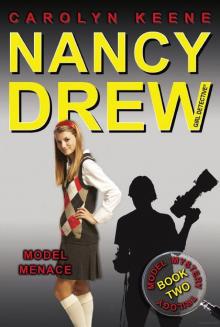 Model Menace 2
Model Menace 2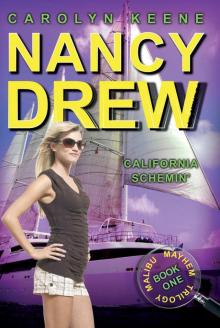 California Schemin': Book One in the Malibu Mayhem Trilogy
California Schemin': Book One in the Malibu Mayhem Trilogy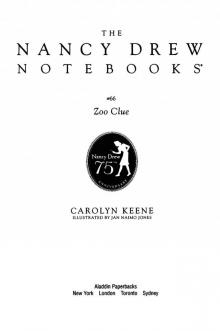 Zoo Clue (Nancy Drew Notebooks)
Zoo Clue (Nancy Drew Notebooks)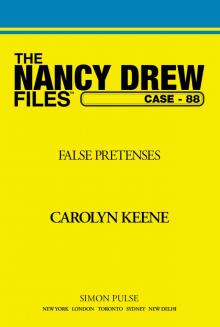 False Pretences
False Pretences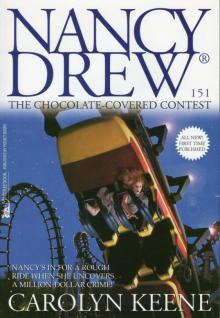 151 The Chocolate-Covered Contest
151 The Chocolate-Covered Contest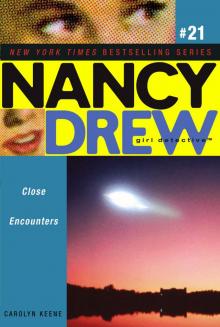 Close Encounters
Close Encounters The Emeral-Eyed Cat Mystery
The Emeral-Eyed Cat Mystery Boo Crew
Boo Crew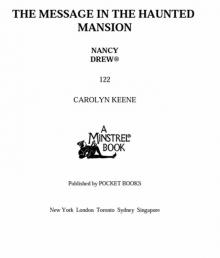 The Message in the Haunted Mansion (Nancy Drew Book 122)
The Message in the Haunted Mansion (Nancy Drew Book 122)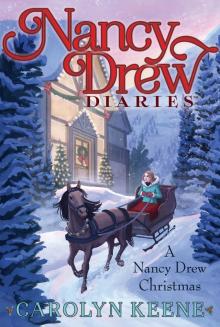 A Nancy Drew Christmas
A Nancy Drew Christmas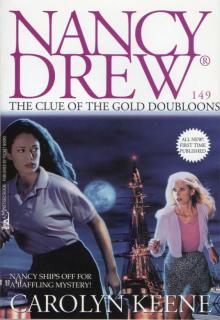 149 The Clue Of The Gold Doubloons
149 The Clue Of The Gold Doubloons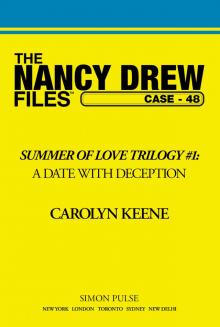 A Date with Deception
A Date with Deception 101 The Picture of Guilt
101 The Picture of Guilt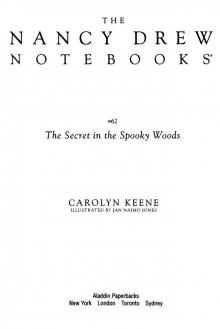 The Secret in the Spooky Woods (Nancy Drew Notebooks Book 62)
The Secret in the Spooky Woods (Nancy Drew Notebooks Book 62)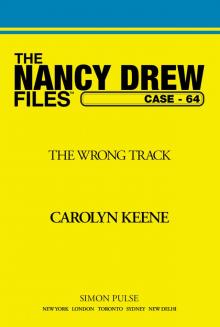 The Wrong Track
The Wrong Track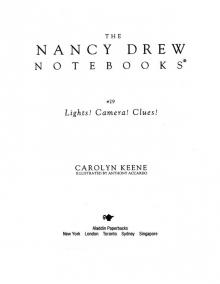 Lights! Camera! Clues!
Lights! Camera! Clues!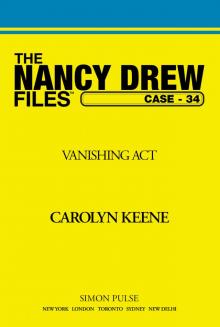 The Vanishing Act
The Vanishing Act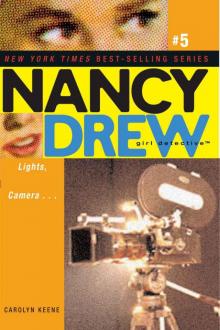 Lights, Camera . . .
Lights, Camera . . .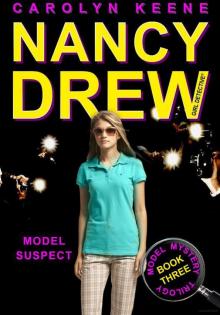 Model Suspect 3
Model Suspect 3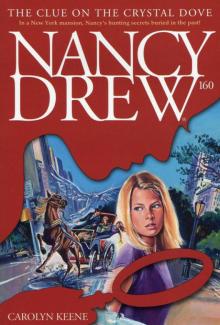 160 The Clue On The Crystal Dove
160 The Clue On The Crystal Dove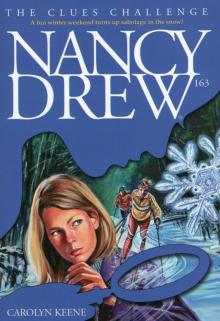 163 The Clues Challenge
163 The Clues Challenge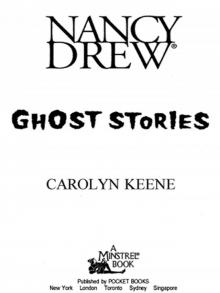 Ghost Stories (Nancy Drew)
Ghost Stories (Nancy Drew)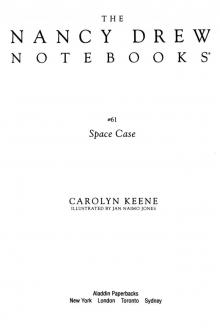 Space Case (Nancy Drew Notebooks Book 61)
Space Case (Nancy Drew Notebooks Book 61)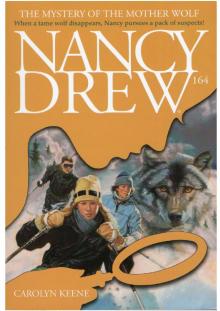 164 The Mystery Of The Mother Wolf
164 The Mystery Of The Mother Wolf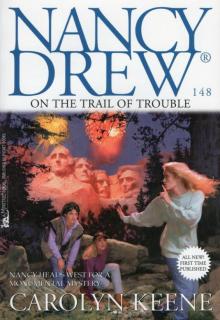 148 On The Trail Of Trouble
148 On The Trail Of Trouble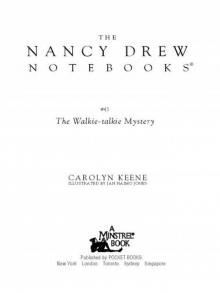 The Walkie-Talkie Mystery
The Walkie-Talkie Mystery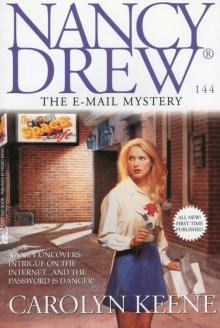 The E-Mail Mystery
The E-Mail Mystery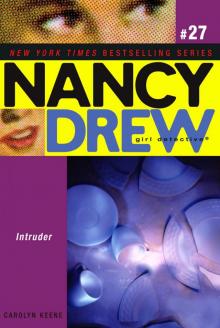 Intruder (Nancy Drew (All New) Girl Detective)
Intruder (Nancy Drew (All New) Girl Detective)![The Stolen Relic [Nancy Drew Girl Detective 007] Read online](http://i1.bookreadfree.com/i2/04/11/the_stolen_relic_nancy_drew_girl_detective_007_preview.jpg) The Stolen Relic [Nancy Drew Girl Detective 007]
The Stolen Relic [Nancy Drew Girl Detective 007]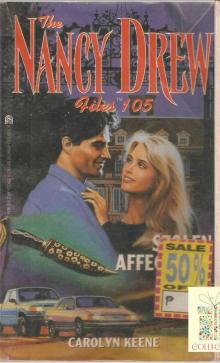 105 Stolen Affections
105 Stolen Affections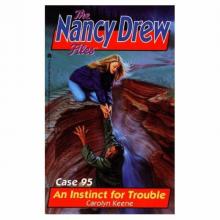 An Instict for Trouble
An Instict for Trouble 161 Lost In The Everglades
161 Lost In The Everglades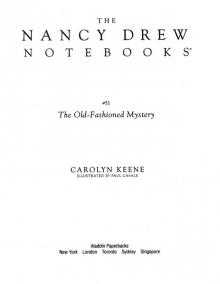 The Old-Fashioned Mystery
The Old-Fashioned Mystery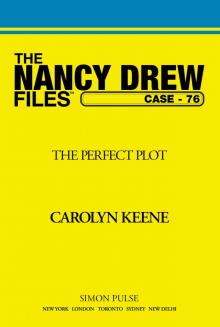 Perfect Plot
Perfect Plot